PART THREE—
NORTHERNERS AT ST. PETER'S AND THE CULTURAL POSITION OF POLYPHONY
Chapter Ten—
Contrapuntal Allusions in Polyphonic Masses
The setting of words to music has always involved textual interpretation, no less in the fifteenth century than in the nineteenth. While Du Fay's methods are less well understood than Schubert's, they are no less sophisticated in their ability to depict nonmusical ideas and images in music or to shape the responses of listeners. In setting words, Renaissance composers used techniques that are fundamentally rhetorical, in the combined senses of persuading and teaching while also entertaining. And because in the fifteenth century composers for the first time made polyphonic cycles of the Mass Ordinary the preferred musical texts—no motet or chanson verses can compare in frequency of settings—they created musical-textual conventions that were truly international. In arguing that a particular polyphonic idea in the Masses of SPB80 (or any other source) has a specific textual meaning, it is necessary to make comparisons to other Masses, so that the merely coincidental can be distinguished from the purposeful. And comparisons of Mass counterpoint to chansons reveal an interaction between secular and sacred genres that goes far beyond the use of a secular cantus firmus as a Mass tenor. In this way it is possible to show that within the Masses of SPB80, certain musical responses exemplify international conventions for interpreting the words of the Mass through music.
On the most basic level, the practice frequently and simplistically called "word painting" in discussions of Italian and Elizabethan madrigals had a long tradition in Mass settings that is occasionally noted but as yet insufficiently explored. Composers interpreted the Mass Ordinary by means of rhythmic alterations (with or without coloration), strict imitation and canon, the number of voices used to set a text, and
even such straightforward depictions as the stepwise ascending lines Du Fay employed for "Et ascendit in caelum" in his early Credo settings and in the Missa Ave regina coelorum , or, in this same Mass, his extended melisma in triplet coloration at "non erit finis." The Missa Thomas cesus , likely by Caron, has an impressive symbolic construction for the Pleni—"heaven and earth are full of your glory." The composer very clearly emphasizes the terrestrial glory, by descending through three pairs of duets, each one lower than the one before: cantus and contra, contra and tenor, and then tenor and bass. Only the opening duet for the upper voices sings of heaven, the lower parts enter with "Et terra." There are similar constructions in the Pleni sections of Caron's Missa Sanguis sanctorum , in Ockeghem's Missa Caput (where he repeated the descending pairs of voices a second time), and in his Missa Mi mi (which concludes with a duet in the upper voices on the word "tua"). In four-voice Masses that reduce to three for the Pleni, it is standard at this time to begin the Pleni as a duet for the upper voices, shift to the lower two voices somewhere in the middle, and then conclude with all three voices at "gloria tua." This scheme occurs in Du Fay's Missa L'homme armé and Missa Ave regina coelorum , in all of the Naples L'homme armé Masses that have a three-voice Pleni, and in Gaspar van Weerbecke's Missa O Venus bant , to name a few. Although scribes did not always neatly divide the Pleni between high "heaven" and low "earth," the symbolic representation is unmistakable.
The term word painting is inadequate to describe the sophistication of the responses that fifteenth-century composers devised for setting the Mass Ordinary. It conjures up a naive hunt for imagery capable of being depicted musically. In their settings of the "Genitum, non factum" clause in the Credo, Du Fay, Caron, and Busnois evidently used either imitative or rhythmic means to convey a common theological interpretation in their counterpoint. Caron's Missa L'homme armé and Busnois's Missa O crux lignum employ the same triadic figure in three-voice imitation for "Genitum, non factum" (Ex. 52). Both are doubtless superseded by the nonimitative appearance of the identical motive in Du Fay's Missa L'homme armé , again at "Genitum, non factum."
It is not just the motive but the presentation of the motive that matters. The difference between Du Fay's single-voice statement and the three-voice imitative rendition favored by Caron and Busnois may have a theological rather than musical impetus. The entrance of the
EXAMPLE 52. Comparison of motives at "Genitum non factum" in the Credos of (a) Caron, Missa L'homme armé , (b) Busnois, Missa O crux lignum , and (c) Du Fay, Missa L'homme armé , superius
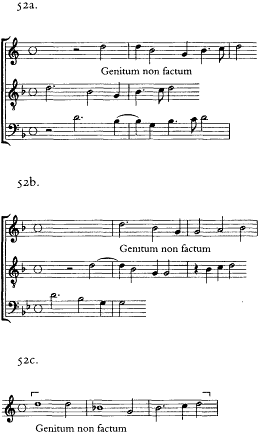
three voices in close succession with the same motive suggests a Trinitarian interpretation: already at the moment of the Conception, the Son and the Holy Spirit were "one in being with the Father."[1] In fact even Du Fay's single-voice statement allows for this reading, since at this text Du Fay shifts to coloration to facilitate his rocking triplet
[1] On the importance and frequency of sermons on the Trinity in medieval and Renaissance theology, see John O'Malley, Praise and Blame in Renaissance Rome: Rhetoric, Doctrine, and Reform in the Sacred Orators of the Papal Court, c. 1450-1521, 96-97.
rhythms; moreover, the bass and contra change independently to different mensuration signs, so that the three contrapuntal voices sing "Genitum, non factum, consubstantialem Patri: per quem omnia facta sunt" in three distinct mensuration signs. In this instance music demonstrably surpassed all other means of expression for representing one of the central theological mysteries of the age: how one God could contain three persons. Over the latter half of the fifteenth century, preachers in the humanist tradition often turned to the analogy of harmonious song to explain the Trinity.[2] That Du Fay, Caron, and Busnois may each have articulated this belief, possibly at different courts, indicates that composers also participated in contemporary theological debates.
Before imitative counterpoint became the stylistic norm in the last decades of the century, composers had more freedom to use imitation as an expressive tool for interpreting those portions of the Mass that either described unity between separate entities or actions such as leading and following. In the Credo the clause "Qui ex Patre Filioque procedit" was regularly set imitatively—a musical demonstration of the derivation of the Holy Spirit from the Father and the Son. Among the Masses in SPB80, Barbingant did so in his Missa and Missa Terriblement , Caron in the Missa L'homme armé , and Faugues, assuming him to be the composer, in the Missa Pour l'amour . Similarly, the imitation often found at the phrase "Et iterum venturus est" probably owes its popularity to the obvious aural imagery that occurs when a single motive is sung polyphonically while the singers reiterate their description of Him "who shall come again." Among numerous examples are Du Fay's Missa Ave regina coelorum , most of the Masses by Faugues, Caron's Missa Sanguis sanctorum and Missa Clemens et benigna , and the Missa Au chant de l'alouete , probably composed by Martini. This treatment is not present in either of the Busnois Masses with attributions (these words are not present in them at all) or in his Patrem de vilayge , but it occurs in virtually all of the Naples L'homme armé Masses (in Mass no. 3 two voices are missing and in no. 6 the text setting is unclear). And this must also be the reason that imitation was so prevalent in Benedictus settings at the entrance of "Qui venit in nomine Domini."
[2] Ibid., 129 and 132.
However necessary it is to be aware of contrapuntal figures with potential textual significance, there is another way in which composers could have made counterpoint serve rhetorical ends. Fifteenth-century composers, as well as artists and writers, often cited earlier works, either literally as quotations or with variations, as paraphrases or allusions. Because composers worked with both music and words, they could allude to a text through a melodic quotation or allusion. In this way, the notes of chanson present in a Mass cantus firmus could refer to the original chanson poetry as a means of offering a commentary on the Mass text actually being sung.[3] But tenors were not the only voices capable of conveying an interpretive allusion, nor were citations of chansons in the contrapuntal voices limited to the chanson cited in the Mass tenor.
Nor was the practice limited to Masses. Indeed the techniques are easier to spot in chansons because, unlike the fixed texts of the Mass Ordinary, the reuse of a poetic phrase is potentially meaningful. Busnois's chanson J'ay mains de biens apparently alludes to the opening motive of Caron's chanson Mourir me fault when it quotes the phrase "mourir me fault."[4] The same sort of melodic allusion occurs between Compère's chanson Me doibt en prendre and the lost chanson Jesuis en la mer . The first measures of this lost chanson can be gleaned from the beginnings of the movements in the Missa Je suis en la mer by Faugues. The chanson by Compare includes the phrase "estre en la mer," set to the notes shown in Example 53. This phrase is similar to phrases in the Mass that probably come from the missing chanson. Faugues did not necessarily base his Mass on a lost chanson by Compère; it is also possible that Compare quoted the unknown composer of the lost chanson Je suis en la met or that someone wrote a chanson based on this particular phrase of Compère's Me doibt en prendre .[5] Both composers presumably intended to depict the motion of the sea in their wavy melodic lines.
[3] Michael Long, "Symbol and Ritual in Josquin's Missa di Dadi. "
[4] This example is discussed in Christopher Reynolds, "The Counterpoint of Allusion in Fifteenth-Century Masses," 238-39. The examples cited in that article complement those presented here.
[5] Connections between the beginning of one chanson and an interior verse of another deserve further study. Another example involves the anonymous Languir me fault en grieuf doleurs (edition in Henrietta Schavran, "The Manuscript Pavia, Biblioteca Universitaria, Codice Aldini 362: A Study of Song Tradition in Italy circa 1440-1480," 2:73-75), which is close textually and musically to a phrase in the anonymous Comme ung homme desconforté (edition in Edward L. Kottick, The Unica in the Chansonnier Cordiforme , 9-10). The third verse of the latter is "Languir me fauldra en tristesse." Similarly, the anonymous Jamais si bien ne me peut avenir (edition in Duff J. Kennedy, "Six Chansonniers Français: The Central Sources of the Franco-Burgundian Chanson," 555) is related to the second part of Hayne's Se une fois recouvrir joie (edition in Howard M. Brown, A Florentine Chansonnier from the Time of Lorenzo the Magnificent: Florence, Biblioteca Nazionale Centrale MS Banco Rari 229 , no. 134), which begins "Jamais homme n'eust le plaisir." For other examples, see Reynolds, "The Counterpoint of Allusion," 229-31. Textual quotations do not always inspire musical citations; e.g., even though the first verse of Busnois's En soustenant vostre querelle quotes from the last verse of Binchois's De plus en plus (and also makes other references), I see no melodic reference. Paula Higgins notes a textual quotation involving the lost Busnois chanson Cent mille fois (verses 1 and 2) and the anonymous Pour les biens (verses 5 and 6); see her "Antoine Busnois and Musical Culture in Late Fifteenth-Century France and Burgundy," 205.
EXAMPLE 53. Motivic comparison of (a) Faugues, Missa Je suis en la mer , Agnus I, mm. 1-4; and (b) Compère, Me doibt en prendre , mm. 22-26
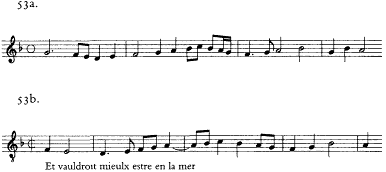
When musical resemblances are supplemented by textual ones, it is easy to recognize allusions, as in the beginnings of Du Fay's Le serviteur hault guerdonné and the anonymous Le serviteur infortuné or, as shown in Example 54, between two voices of Joye's Mercy mon dueil and the anonymous Mon cuer de dueil partira . But as the textual similarities diminish, so too does the ability to recognize significant musical parallels. The important role of textual ties is evident in the possible instances of allusion presented in Example 55, where the opening of the chanson Se je fayz dueil by Le Rouge is compared to the anonymous
EXAMPLE 54. Comparison of counterpoint in (a) Joye, Mercy, mon dueil , mm. 1-11; and (b) Anonymous, Mon cuer de dueil , mm. 1-7
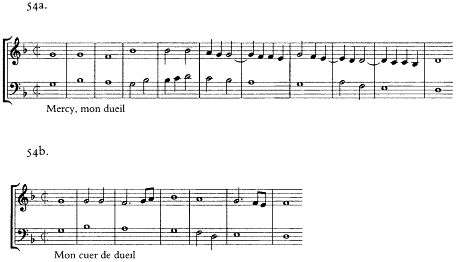
EXAMPLE 55. Comparison of counterpoint in (a) Le Rouge, Se je fayz dueil , mm. 1-14; and (b) Anonymous, Combien le joyeulx que je fasse , mm. 1-8
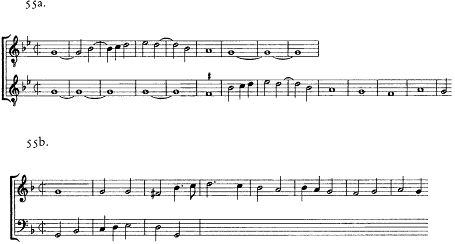
Combien le joyeulx je fasse .[6] The Le Rouge tenor resembles the superius of Cornbien le joyeulx , and his superius the contra. Both poems are octosyllabic bergerettes, and although Combien le joyeulx je fasse has only one flat in the signature, two eb's are written out and ficta considerations demand others. The anonymous chanson seems to play textually as well as musically on Se je fayz dueil . The sadness that is "made" in Le Rouge's chanson becomes a false joy in the other chanson, recounted in the present subjunctive of "faire." And whereas Se je fayz dueil is the lament of a soul tormented by the poet's separation from his lover, the other describes a heart that bears "a great mass of painful unhappiness" because of the poet's separation from his homeland, France. The musical resemblances are strong primarily because of the textual similarities.
The inability to examine poetic parallels in Examples 56a and b makes it correspondingly more difficult to assess the importance of the musical similarities. The first phrase of Binchois's De plus en plus se re-nouvelle resembles one of the untexted chansons by Constans in Tr90.[7] If it also had a text that was comparably close to De plus en plus , we could assert that the musical parallels were not simply coincidental but indicative of a purposeful allusion.
The Du Fay chanson Navré je suis in Example 56c has only the vaguest motivic link with De plus en plus —they pursue similar paths through the same modal species of fifth and fourth and a poetic connection that is hardly more convincing: the end of the second verse, "de part en part," may be read as a grammatical allusion to Binchois. Yet in arguing for the existence of an allusion, other sources of information help interpret the two verses being compared. In this case there are two external reasons for associating Du Fay's chanson with Binchois. First of all, Du Fay's Navré je suis d'un dart pénétratif has a pronounced
[6] There is an edition of Se je fayz dueil in Leeman Perkins and Howard Garey, The Mellon Chansonnier , no. 31; and of Combien le joyeulx je fasse in Brown, A Florentine Chansonnier , no. 223. In the latter edition the first line of the poem is rendered "Combien le joyeulx que je fasse," "for the sake of the meter" (text volume, p. 295), although both sources (Flor229 and Paris 15123) agree in omitting the "que."
[7] Published in Jean Marix, Les musiciens de la cour de Bourgogne au XVe siècle, 1420-1467 , no. 58. Constans is presumably the teacher of Hayne, Constans de Languebroek, long a member of the Burgundian court, along with Binchois.
EXAMPLE 56. Motivic comparison of (a) Binchois, De plus en plus , mm. 1-5; (b) Constans, textless, mm. 1-12; and (c) Du Fay, Navré je suis d'un dart , mm. 1-5
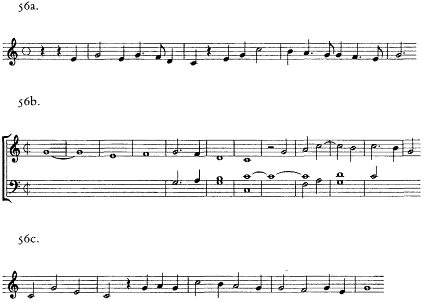
similarity to the poetry of Ockeghem's Deploration sur la mort de Binchois , which begins "Mort, tu as navré de ton dart." Ockeghem and Du Fay may both be alluding to words they associated with Binchois. And second, based on stylistic and manuscript evidence, Du Fay probably composed his chanson about the time he met Binchois in 1434.[8]
Contrapuntal Allusions in Masses
The first comparisons of contrapuntal lines in Masses and chansons are intended to show how close the correspondences could be. They juxtapose chanson motives with Mass motives that are not taken from the chanson sung in the tenor. In the anonymous Missa in SPB80 (fols.
[8] Graeme Boone, "Dufay's Early Chansons: Chronology and Style in the Manuscript Oxford Bodleian Library, Canonici 231," 136.
EXAMPLE 57. Anonymous, Missa (SPB80, fols. 129v-43), Crucifixus at "Et resurrexit"

129v-43), three voices of the Et resurrexit (Ex. 57) may refer to a secular composition without a known text, the chanson by Constans in Tr90 just noted for its similarity to De plus en plus se renouvelle (Ex. 56b). The next of these preliminary comparisons involves an interior phrase. In the Kyrie I of Caron's Missa Accueilly m'a la belle the second phrase (mm. 4-8) makes its own citation of Binchois's De plus en plus (Exs. 58a and b). Caron here creates a double allusion, because the second phrase of his chanson Accueilly m'a la belle (Ex. 58c) is also plainly related. The reference in the Mass to Binchois becomes distinctive in the second half of the phrase, when Caron replaces the chanson with the same short cadential figure used by Binchois. Perhaps because Caron had no option in a Kyrie of relying on a secular text to draw attention to his melodic citation, the motivic resemblance to De plus en plus is stronger than in either of the chansons discussed above in Example 56. The same reason may apply to Example 59, where the chanson Pourtant se mon voloir s'est mis by Caron (or Busnois) is virtually quoted in the Benedictus of the Missa Pour l'amour (and less extensively at the Christe), attributed to Faugues.
Textual correspondences and contemporary rhetorical practices make it unlikely that all of these similarities are purely melodic coincidences. Of the possible quotations cited in earlier chapters, one presented in chapter 6 (Ex. 2i)—namely, Le Rouge's Se je fayz duel and the Qui sedes of Faugues's Missa La basse danse —has an affinity between the sacred and secular texts that was not discussed. The allusion at the injunction "You who sit at the right hand of the Father, hear our prayer" is to the lament of pain and suffering voiced in the chanson. To include an example from earlier in the century, the Cum Sancto of an independent Gloria setting by Du Fay in Tr92 quotes
EXAMPLE 58. Motivic comparison of (a) Binchois, De plus en plus , mm. 1-5; (b) Caron, Missa Accueilly , Kyrie I, mm. 4-8; and (c) Caron, Accueilly m'a la belle , mm. 8-12
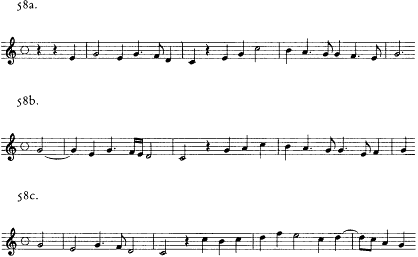
EXAMPLE 59. Motivic comparison of (a) Caron (or Busnois), Pourtant se mon voloir s'est mis , mm. 1-7; and (b) [Faugues], Missa Pour l'amour , Benedictus, mm. 1-8
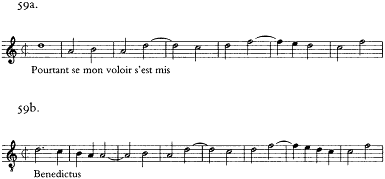
EXAMPLE 60. Motivic comparison of (a) Du Fay, Adieu, quitte le demeurant , mm. 1-3; and (b) Du Fay, Gloria (no. 28), at "Cum sancto"
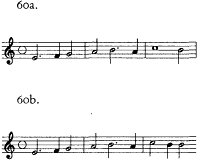
from Du Fay's chanson Adieu, quitte le demeurant de ma vie (Ex. 60). The combined imagery of the chanson (leaving "the abode" of one's life) and the Mass ("with the Holy Spirit in the Glory of God the Father") suggests a vision of life after death, whether for Christ or a recently deceased acquaintance of Du Fay.[9]
Several motivic allusions with possible textual significance occur in the anonymous Missa in SPB80 on fols. 90v-98v. The Cure Sancto begins with the same motto as the Busnois setting of Regina coeli laetare (I) (Ex. 61a); then at the Credo text "Et ascendit" there is an extended similarity to the phrase "Me fait celle qui passe route" in the Hayne chanson De quatre nuyts (Ex. 61b); and the Benedictus also suggests Hayne (Ex. 61c). Both voices of this duet closely resemble the second half of Hayne's chanson Ce n'est pas jeu at the verse "Accompaigné de deuil."[10] In an allusion that recalls the prophecies Jesus made in the Sermon on the Mount, the composer therefore appears to suggest that
[9] This Gloria is in Guillaume Dufay, Guillelmi Dufay Opera Omnia , vol. 4, no. 28. Among quotations noted by others, there are those Besseler cited in his foreword to this volume of Mass fragments; and Charles Van den Borren suggested that Brumel based the "Et unam sanctam" in the Credo of his Missa De beata virgine on Compère's Nous sommes de l'ordre de Saint Babouin . The connection between an identification with a special Order and the belief in "one, holy, catholic, and apostolic church" is hard to miss; see Van den Borren, La musique en Belgique de moyen âge à nos jours , 80-81; and also Ludwig Finscher, Loyset Compare (c. 1450-1518) , 241-42.
[10] For an edition, see Marix, Les musiciens , no. 67.
EXAMPLE 61. Motivic comparison
EXAMPLE 61A . (i) Anonymous, Missa (SPB80, fols. 90v-98v), Cum sancto; and (ii) Busnois, Regina coeli laetare

EXAMPLE 61B . (i) Anonymous, Missa (SPB80, fols. 90v-98v), Et incarnatus at "et ascendit"; and (ii) Hayne, De quatre nuyts at "Me fait celle"

EXAMPLE 61C . (i) Anonymous, Missa (SPB80, fols. 90v-98v), Benedictus; and (ii) Hayne, Ce n'est pas jeu at "Accompaigné de deuil"
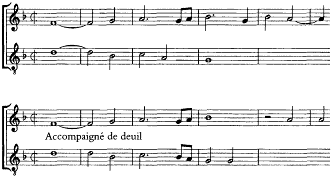
the "blessed who walk in the name of the Lord" are those "accompanied by sorrow."
Contrapuntal references to a chanson could operate on two textual levels: as a commentary on the Mass text but also as an amplification of whatever poetic "theme" existed in the cantus firmus.[11] When Caron alluded to Binchois's De plus en plus in his Missa Accueilly m'a la belle (Ex. 58), he did so because the messages of the two chansons supplement each other. While the spurned singer of Caron's text complains of his inability to see or meet with his lady, that in De plus en plus declares his great desire to hear news of his "sweet Lady" and vows that his will to see her is "more and more ... renewed."
Another instance of this sort of textual relationship is present in one of the anonymous Masses in SPB80. The first motive of the anonymous chanson D'un bon du cuer sans aultre amer appears in the middle of the Qui tollis of the Missa D'ung aultre amer (Exs. 62a and b) at "Qui tollis peccata mundi, suscipe deprecationem nostram" [You who take away the sins of the world, hear our prayer]. At the final phrase of the chanson, when the poem returns to the words "aultre amer," the opening motive comes back in imitation at the octave (Ex. 62c). This imitation seems to have inspired the more taxing imitation at the second below in the Qui tollis. If the pairing of the poet's request for his love "not to love another" seems frivolous to include at the Qui tollis, the justification for this particular reference may be based on a pairing of one chanson about "un aultre amer" with another.
It was also possible for a citation to reverse the direction of the allusion, that is, for a chanson to allude to a Mass setting. In his Missa Caput Ockeghem uses a motive at "Et resurrexit" that compares closely to three chanson beginnings. Two of the chansons may well have been written by the same anonymous composer (Barbingant?), Terriblement suis fortunée and Fortune, n'as-tu point pitié . Yet the chanson with the strongest rhythmic as well as motivic similarity is Compère's Le renvoy d'ung cueur esgaré .[12] The textual concordance of the Resurrection and
[11] I discuss this sort of connection between Du Fay's Missa Se la face ay pale and Puyllois's He nesse pas grant desplaysir in "The Counterpoint of Allusion," 243-44.
[12] This example is in Reynolds, "The Counterpoint of Allusion," 240-41. Compère's imitative chanson doubtless follows the two anonymous nonimitative ones and is therefore perhaps another instance of Compare beginning a chanson with a motive first used by Barbingant. Regarding Terriblement suis fortunée and Fortune, n'as-tu point pitié , see ibid., 229-31.
EXAMPLE 62. Comparison of motives and counterpoint of (a) Anonymous, D'un bon du cuer sans aultre amer , mm. 1-4; (b) Anonymous, Missa D'ung aultre amer , Qui tollis, mm. 22-28; and (c) Anonymous, D'un bon du cuer sans aultre amer , mm. 41-45
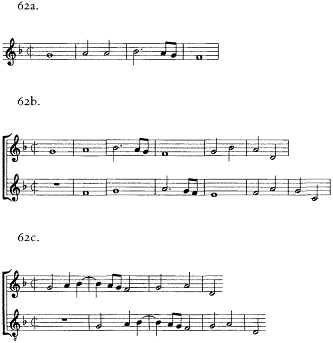
"the return of a heart misled" creates a convincing rhetorical image, regardless of which was composed first. To anyone who knew both the chanson and the Mass, the notes of one would call to mind those of the other. The debt of a secular work to sacred is particularly apt in this instance, since the superius of the chanson Terriblement suis fortunée quotes the chant melody Terribilis est locus iste .
In each of these examples, a chanson incipit appears to shape the melodic turn for a brief, textually related segment of a Mass by one
EXAMPLE 63. Motivic comparison of (a) Anonymous, Comme ung homme desconforté , mm. 1-9; (b) Busnois, Magnificat octavi toni , Et misericordia ejus, mm. 1-4; (c) Busnois, Magnificat sexti toni , Quia respexit humilitatem; (d) Lanoy, Missa , Agnus II, mm. 1-3; (e) Anonymous, Missa L'homme armé (Bol Q16), Agnus II, mm. 1-5; and (f) Martini, Missa Coda pavon , Patrem, at "Et homo factus est"
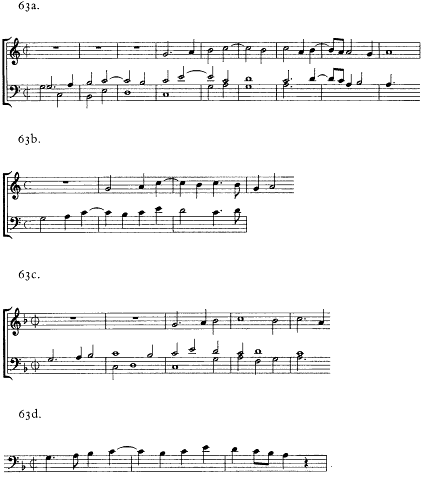
(continued )
EXAMPLE 63 (continued )
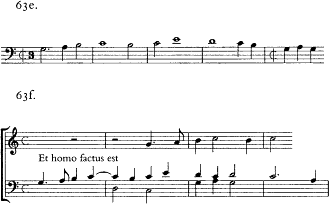
composer. However, there are clearer instances of allusive quotation in chansons that are cited in more than one work. Busnois, probable composer of the Magnificat Octavi toni (SPB80), quotes two voices of the anonymous Comme ung homme desconforté at the verse "Et misericordia" and three voices in his Magnificat Sexti toni at "Quia respexit humilitatem" (Ex. 63). Two Masses appear to cite the chanson tenor at the Agnus II, Lanoy's three-voice Missa (SPB80) and the anonymous Missa L'homme armé in BolQ16. And Martini has a more complete quotation in the Credo of his Missa Coda pavon at "et homo factus est." The image of someone "in great distress" suits equally well the plaintive tone of the Agnus Dei ("O Lamb of God have mercy") and the Magnificat verses "And His mercy is from generation to generation" and "Because he has regarded the lowliness of his handmaid." If this chanson casts a somber light on the Credo text "and He was made man," it should perhaps be related to fifteenth-century paintings of Madonna and child that portray Mary with an expression of grief, as if she knows from the outset the fate that awaits her child.
Multiple citations of a single chanson, or Masses that quote several phrases of a single chanson, offer a more secure means of identifying the presence of allusion or quotation than do single citations. Because Caron is the most active composer represented in SPB80 in this regard, and one particularly apt to quote from his own chansons, the following examples focus on his works.
Caron, Ockeghem, and the Anonymous Missa , SPB80, Folios 122-29
I have argued elsewhere that Caron incorporated a complex of motivic allusions to his chanson O vie fortuné in the Credo of his Missa Sanguis sanctorum .[13] From the duet at Et resurrexit through the four-voice entrance at "Cuius regni non erit finis," Caron begins each phrase with motives from this chanson. Similarly, the Agnus II of Caron's Missa L'homme armé stands squarely in the midst of a motivically interrelated group of movements by various composers. The associations of this one section of Caron's Mass extend to movements in Ockeghem's Missa (à 3), the anonymous Missa in SPB80 (fols. 122-29) that has traits of Bedyngham, the sixth Missa L'homme armé of the Naples set, and the anonymous Missa Gross sehnen , as well as to several chansons. In all but the last two of these Masses, the movement in question is the Agnus II. Perhaps the earliest are those by Ockeghem and the anonymous composer in SPB80. As shown in Examples 64a and b, the Agnus II duets begin with the same pair of motives, although Ockeghem and the anonymous composer switch voices and one begins on f and the other on g. These two movements also conclude with the same sequential duet.
Caron evidently derived his Agnus II from that by Ockeghem (Exs. 64b and c). The motive in the superius takes the same upward turns to

[13] For the musical examples, see Reynolds, "The Counterpoint of Allusion," 242. This is the title of the chanson in Flor229. Textual incipits in other sources identify the chanson as Vive fortunée (Paris i5123, which shares its corrupt text with Flor229), Vive fortune (Seville 5-I-43), O vive fortune de divers (C.G. XIII, 27), and Adieu fortune (Rome 2856).
marked with an "x." As discussed below, there are other ties between these two movements, ties that will also provide a reason to include in this group the Osanna I from the anonymous Missa Gross sehnen (Ex. 64e), despite the absence of the accompanimental counterpoint.
The relationship between the upper voices of the Caron Agnus and the Naples Benedictus has been observed before, one scholar claiming that it points to Caron as the composer of the whole cycle, another identifying Busnois.[14] This type of melodic relationship has to be used carefully in an argument about attribution, because it is the kind of quotation that composers routinely made of one another. For the same reason that Caron cannot be claimed as the composer of Ockeghem's Missa , he should not on this evidence alone be credited with the Naples L'homme armé cycle. The point is not just that one composer could start a Mass movement by quoting the head motive from the Mass movement of another composer but that they both could be alluding to some other work altogether.[15]
In this particular instance the composers could have been referring to any of several chansons that begin with some permutation of the opening counterpoint. The first measures of the superius that Ockeghem and the others used exists in the anonymous Mon cuer de dueil and Joye's Mercy, mon dueil (shown in Ex. 54), as well as in Hayne's Amours, amours, trop me fiers and chansons by Horlay and Busnois.[16] And the first three of these chansons begin with the combination of superius and contra motives found in the anonymous SPB80 Mass and in the Ockeghem Agnus. It is significant enough that these movements commence with a gesture so characteristic of chansons being written at the same time. The correspondence underscores the common contrapuntal and melodic language composers had for chansons and Masses
[14] Don Giller, "The Naples L'homme armé Masses and Caron: A Study in Musical Relationships," argues for Caron on motivic grounds; Richard Taruskin, "Antoine Busnoys and the L'homme armé Tradition," favors Busnois for his use of canons and approach to mensuration (see n. 25, below).
[15] Any instance in which one Mass appears to cite a contrapuntal voice of another is potentially an indication that the earlier Mass is itself citing some earher work. However, I do not claim that this was always the case. Some citations may function as an homage to a particularly influential Mass. This perhaps explains why Obrecht "quotes the first ten perfections of the superius part of the English Caput Mass" in his contra, as noticed by Alejandro E. Planchart, "Fifteenth-Century Masses: Notes on Performance and Chronology," 17.
[16] Horlay, Helas, je suis livré a mort , and Busnois, Mon seul et celé souvenir .
EXAMPLE 64. Comparison of counterpoint in (a) Anonymous, Missa (SPB80, fols. 122v-29), Agnus II, mm. 1-9; (b) Ockeghem, Missa (à3), Agnus II, mm. 1-9; (c) Caron, Missa L'homme armé , Agnus II, mm. 1-11; (d) Anonymous, Missa L'homme armé (Naples 6), Benedictus, mm. 1-15; and (e) Anonymous, Missa Gross sehnen , Osanna I, mm. 1-4
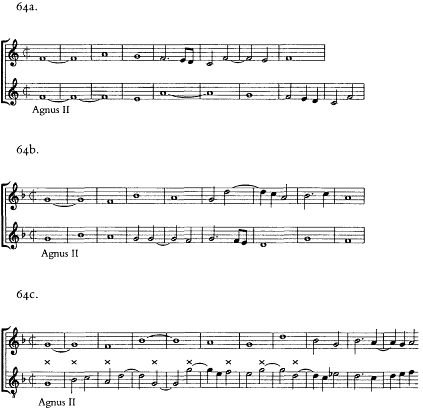
(continued )
in the mid-fifteenth century. But the significance of this is not purely stylistic. With regard to the Agnus II by Caron and the Naples Benedictus it is possible to go beyond descriptive analysis on the basis of other, previously unobserved, musical correspondences. One of these chansons seems particularly likely to have inspired the composers textually.
Caron and the composer of the Naples Mass have a second theme in
EXAMPLE 64. (continued )
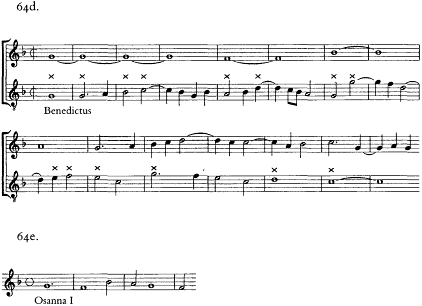
their movements, the same in both. Midway through each duet—that is, in the Caron Agnus at measure 22 of forty-four, and in the Benedictus at measure 34 of seventy—both composers come to a Phrygian cadence on a and then shift to triple meter (Exs. 65a and b).[17] The anonymous composer varies the new motive by transposing it up a fifth, by filling in the leap of a fourth with stepwise motion, and by disguising the hemiola with syncopation. He leaves unchanged the interval of imitation, which comes at the octave above at a distance of two breves, and he also duplicates the approach to this point of imitation. Most of the counterpoint in the six breves that lead up to this juncture is also based on Caron (the shared notes are marked with an "x").
[17] The Agnus II of the second Naples Mass may also have had this tune. It too cadences on a at exactly the halfway point but then breaks off while the lower voices continue with a duet that has perished. And the Benedictus of the fifth Naples Mass seems constructed as an anticipation of the Benedictus for Mass no. 6. Measures 1-3 of no. 5 prefigure the beginning of the last Benedictus in both voices, and the imitation at mm. 11-13 varies the entry of the second theme.
EXAMPLE 65. Mass movements possibly related motivically to Caron, Mort ou mercy : (a) Caron, Missa L'homme armé , Agnus II, mm. 18-29; (b) Anonymous, Missa L'homme armé (Naples 6), Benedictus, mm. 29-42; (c) Caron, Mort ou mercy , mm. 1-11; and (d) Anonymous, Missa Gross sehnen , Osanna II, mm. 1-6
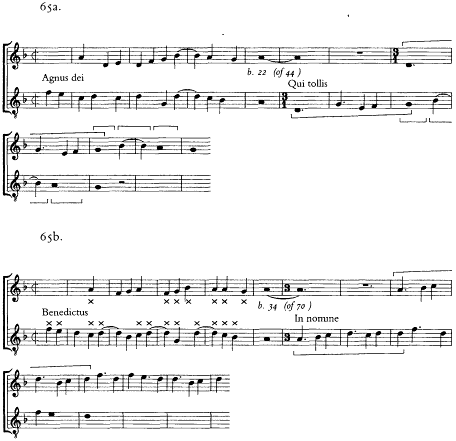
(continued )
The source of this motive is most likely Caron's chanson Mort ou mercy (Ex. 65c). In the Mass the meter is triple rather than duple, but this metric alteration is perhaps suggested by the rhythmic ambiguities of the chanson. Although the bass voice of the chanson is omitted in these Mass movements, the interval of imitation remains the same, and
EXAMPLE 65 (continued )
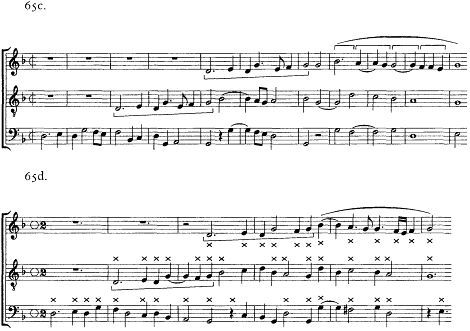
the composer of the Naples Mass includes the final cadential formula in the superius. Finally, all three voices of the chanson appear in a third Mass, the anonymous Missa Gross sehnen (in Ex. 65d the notes of the chanson are once again marked "x"). Here they begin the Osanna II. This is the Mass in which the Osanna I began with the same chanson motive (Ex. 64e) that also came at the start of the Agnus II and Benedictus movements. And just as the Mort ou mercy motive came exactly in the middle of those movements, in the Missa Gross sehnen the Osanna I is exactly as long as the Osanna II, twenty-one perfect breves, so that even in this separated state, this motive essentially begins the second half of the Osanna pair.[18] Remarkably, three separate Masses link these two chanson motives in the same sequence.
The Mass that makes the most sense in terms of a match between
[18] The count of the Osanna I includes the one-measure extension of the contra. If this breve is omitted the Osanna is twenty breves long, and my point remains unchanged.
the sacred and secular is Caron's Missa L'homme armé , apparently the earliest of the three. The text of Caron's Mort ou mercy fits perfectly with the plaintive spirit of the Agnus. While the liturgical text being sung prays to the Lamb of God for mercy, the words alluded to by the chanson melody make the same request in earthly terms:
Death or mercy I ask of you indeed,
My only beloved,
For I am so stricken with grief
That, by my soul,
There is no one sadder in this kingdom.
But I thank
Love who wills that it should be thus,
And you too,
Who carry the amorous flame
By which I am killed.[19]
Of those chansons that are melodically close to the beginning motives, or that have the two-voice contrapuntal similarity, only one is an easy match for the sentiments expressed in Mort ou mercy . Each of them is dolorous in its own way. The anonymous Mon cuer de dueil is a song of parting, and Horlay's Helas je suis livré a mort one of a loyal servant unfairly wronged. Hayne's Amours, amours, trop me fiers comes closer in that the poem once pleads with Love to stop sending its painful arrows. But by far the closest both to the sentiments of Caron's Mort ou mercy and to those of the Agnus Dei is Joye's Mercy, mon dueil (Ex. 54a); indeed, it reads like a paraphrase of the threefold Agnus Dei:
Have mercy, my grief, I beg of thee,
O grief full of melancholy,
Have mercy, a hundred thousand times I entreat thee,
And come put an end to my soul,
That longs for death,
and then forget me.[20]
Both chansons speak of death and mercy, and where Caron claims that "no one [is] sadder in this kingdom," Joye's poem later has an echo, describing a destiny that is "the most tormenting of this kingdom."
[19] The translation is by Max Knight, in Brown, A Florentine Chansonnier , text volume, p. 244.
[20] Perkins and Garey, The Mellon Chansonnier , 2:278-79.
For the quotations of these chansons in the Benedictus and Osanna movements it is difficult to see any relation between the chanson and Mass texts. For the sake of comparison, in the Benedictus of his Missa L'homme armé , Caron evidently quotes two voices of the chanson Je suis venue vers mon amy (with attributions to Busnois and Hayne) at "in nomine."[21] For a text that refers to someone who "comes in the name of the Lord," the allusion of the chanson tune is germane. The Missa Quand ce vendra also turns to this tune at the same spot of the Benedictus, and it also occurs in the second Naples L'homme armé Mass at the Credo verse "Et incarnatus."
Buttressing the textual similarities of Mort ou mercy and Mercy, mon dueil are musical ones. Joye's chanson apparently provided the model. The first phrase of Caron's chanson, although it begins differently, concludes with a three-voice quotation from Mercy, mort dueil . As shown in Example 66, by measure 8 of the Caron the lines agree in pitch and rhythm, coinciding for the following six breves. Even before this point Caron's lines are closely related to Joye's (shared pitches marked by "x"). The second phrases, after dissimilar openings, also take common approaches to the cadence. And the last phrases have related beginnings. With Joye proceeding by leap and Caron by step, the tenors move sequentially by fourth up an octave: D-G,


In the Masses related to these two chansons, it is inappropriate to speak of "an" allusion when faced with so many movements drawing from the same motivic material. At the outset there was a single allusive reference, but by the last instance, doubtless that in the Missa Gross sehnen , the chain of references extended through five Masses and at least two chansons. Either Ockeghem or the anonymous Mass in SPB80
[21] The chanson is published in Brown, A Florentine Chansonnier , no. 29. In Glogauer the text is a Marian poem, O stella maris . Because this text fits more easily than the corrupt French text, Brown proposes that the Latin text may be the original (text volume, pp. 132-35). It too expresses a thought compatible with the Benedictus text, asking Mary to "lead us ... to the fold of heaven" (translation from Brown, ibid., 135, n. 51).
EXAMPLE 66. Comparison of (a) Joye, Mercy, mon dueil , mm. 1-11; and (b) Caron, Mort ou mercy , mm. 5-14
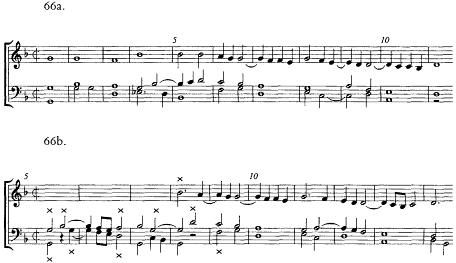
initiated the allusions by referring to a single chanson. By the time Caron composed his Agnus, the multiple allusions had begun. Caron seems to have referred both to Ockeghem's Agnus and to chansons composed by himself and by Joye (and his chanson has its own debt to Joye). The composer of the Naples set, in turn, is another step removed from Ockeghem.[22] And whoever composed the Missa Gross sehnen may have been aware of the whole complex or just of the precedents of Caron and Naples. This distinguished Mass exhibits many features characteristic of Busnois.
Since Caron's Missa L'homme armé may have been copied at St. Peter's in 1463, then the other Masses (and the chansons) would be earlier or later according to where they stand in this complex of references. An earlier date for the anonymous Mass in SPB80 is also indicated by
[22] When in the middle of the Benedictus he transposed the reference to Mort ou mercy and added passing notes to the ascending fourth, perhaps the sole intent was to vary the exemplar; but he may also have made these particular changes in order to introduce an allusion of his own: the resultant motive looks distinctly like the tenor of Morton's chanson, Cousine trop vous abusés .
its position in the first layer of SPB80, that possibly copied in 1461. However, for the Ockeghem Missa , which survives only in Ver759, this provides a basis for dating the work much earlier than the "ca. 1480s" copying of the manuscript.[23]
Substantially the same cast of characters is involved in a second series of allusions. This time the Benedictus of the anonymous Missa (SPB80, fols. 122-29) shares its head motive with the Benedictus and three other sections of Caron's Missa Accueilly m'a la belle , the Agnus II of the third Naples L'homme armé Mass, and the Patrem of Ockeghem's Missa Ecce ancilla . All of these movements begin with motives related to Caron's chanson Pour regard doeul (Ex. 67). As in the chanson, many of these motives continue with a rest and then a second shared motive. For the head motives of the Pattern, Sanctus, Benedictus, and Agnus Dei of Caron's Mass, Pour regard doeul supplants the head motive of the Kyrie and Et in terra, which, as one would expect, are based on Accueilly m'a la belle , also by Caron. In the Benedictus he derived both of the contrapuntal voices from the first phrase of Pour regard doeul (compare Exs. 67d and e) and also the second series of entrances at "qui venit" from the imitative figure that begins the second part of the chanson. Not only the motive but also the imitative counterpoint at the lower fifth are the same (Ex. 67f). These entrances may have inspired Ockeghem's more intricate treatment of the head motive in his Patrem (Ex. 67g).
Caron's Mass is both the most dependent on Pour regard doeul and the easiest to interpret textually, with regard not to the Mass text but to the chanson acknowledged in the cantus firmus. The poems Pour regard doeul and Accueilly m'a la belle expound a common theme: a suitor made unhappy by his lady's refusal to return his love. Where the latter chanson complains that "She has received me ill ... / Turning my well-being into a painful pass. / She has turned away from me her loving greeting," the only surviving stanza of the former claims that there
[23] Masakata Kanazawa, "Two Vespers Repertories from Verona, ca. 1500," 156-59. The Ockeghem Missa may contain another chanson reference also found in Masses by Busnois and Caron. His Benedictus appears to quote the anonymous chanson Faulx envieulx et megre face (Brown, A Florentine Chansonnier , no. 190); so too does the Crucifixus of the second Naples L'homme armé Mass and the Qui tollis of Caron's Missa Jesus autem transiens .
EXAMPLE 67. Comparison of (a) Anonymous, Missa (SPB80, fols. 122-29), Benedictus, mm. 1-7, and motivically related compositions: (b) Anonymous, Missa L'homme armé (Naples 3), Agnus II, mm. 1-11; (c) Caron, Missa Accueilly , Patrem, mm. 1-5; (d) Caron, Pour regard doeul , mm. 1-6; (e) Caron, Missa Accueilly , Benedictus, mm. 1-10; (f) Caron, Missa Accueilly , Benedictus, mm. 21-24; and Caron, Pour regard doeul , part 2; and (g) Ockeghem, Missa Ecce ancilla , Patrem, mm. 1-5
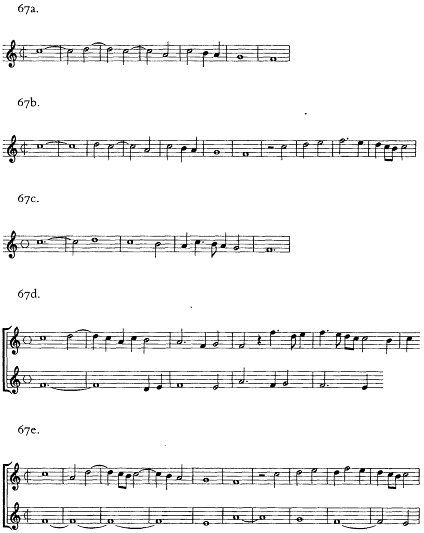
(continued )
EXAMPLE 67 (continued )
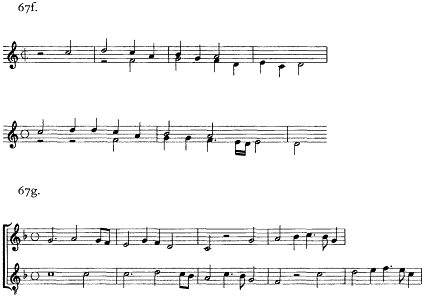
is "one single comfort that I do not have from my mistress" and then asks Love why it is that "I am numbered among the perfectly unhappy?"[24] Caron's allusion in this Mass to Binchois's De plus en plus (noted above in Ex. 58) contributes its own woeful amplification of these thoughts: "And so if you are cruel to me / I would have such anguish in my heart / that I very well would want to die."
In this series of allusive quotations, the chronological sequence of movements differs from the probable order of the Masses presented in Example 64. There the relative simplicity of Ockeghem's Missa , Agnus II, casts it as an earlier setting than either that by Caron or the composer of the Naples Mass. In contrast, his contrapuntal handling of the head motive in the Missa Ecce ancilla is more involved than that of either Caron or the third Naples Mass. And unlike the clear relationship between Caron's L'homme armé Agnus II and the sixth Naples Mass, the evidence of Example 67 offers no clear indication of the priority of the
[24] The translation of Accueilly m'a la belle is by Garey, in Perkins and Garey, The Mellon Chansonnier , 2:195-96.
Missa Accueilly m'a la belle over the Naples setting.[25] The other unknown in both Examples 64 and 67 is the place of the anonymous SPB80 Missa . Because it occupies an apparently central position in both series, and by virtue of its presence in the oldest layer of SPB80, it is the most likely to be the Mass that initiated the chain of allusions. That it contains traits of Bedyngham (see pp. 170-71) casts this British master, or someone with a style very close to his, in an influential role on Caron, Ockeghem, and the composer(s) of the six Naples L'homme armé Masses.
Considering the international makeup of the curia and the popularity of French chansons in Italy during the mid-fifteenth century, it is to be expected that northern Mass polyphony copied—and in some cases probably composed—by northerners at St. Peter's would include references to French chansons. To recognize these motivic resemblances not simply as common occurrences of pitches but as shared motivic allusions is to realize that, like secular cantus firmi reused in several Masses, contrapuntal citations of chansons could acquire a textual authority. This is particularly apparent when like motives are repeated with like texts in different Mass settings. As with tenors, the process by which a contrapuntal motive acquired such an authority is little understood; it may have originated with the request of a patron for a particular combination of secular and sacred texts, or it may have stemmed from the emulation of a respected colleague, someone with the prestige that Ockeghem or Dunstable presumably possessed. In
[25] Additional contrapuntal similarities between Caron's Mass and the Naples Mass exist in the entrances at "Qui tollis" in the settings of the Agnus II. These and Exs. 64 and 67 have implications for who wrote the Naples L'homme armé Masses. The dispute has focused on Caron and Busnois (above, n. 14). While the cumulative weight of the motivic resemblances points to Caron, the full extent of the stylistic similarities of Busnois and Caron has yet to be grasped. They were clearly familiar with each other's music: Witness the several chansons with attributions to both, the "mourir me fault" quotation (cited in Reynolds, "The Counterpoint of Allusion," 229), and the common usage of the triadic imitative figure (Ex. 52. above) at "Genitum, non factum" in Masses securely ascribed to each of them (and the appearance of the same figure in the Qui tollis of other Masses). Moreover, the style of Johannes Touront is very close to that of Caron, Busnois, and the Naples set. The possibility that the six Masses have more than one composer should not be excluded. Although one composer presumably conceived the overall plan of the set, two (or more) could have collaborated on the realization.
any case, a theory of musical influence that includes an awareness of motivic-textual allusions is persuasive because it is supported by the rhetorical practices of the period. The expression of otherworldly beliefs in worldly terms has a strong foundation in the rhetorical thought from the late fourteenth century into the sixteenth.
Chapter Eleven—
Northern Polyphony, Northern Composers, and Humanist Rhetoric
By implication the musical practice described in the preceding chapter contradicts the view that French and Flemish composers were, as products of a northern scholastic environment, inherently insensitive to the aims and methods of Italian humanists. This is the contention of two influential studies, one that examined humanists who dealt seriously with music and the other, music theorists who were also humanists.[1] My disagreement with their conclusions has in the first case to do with the assumption that the humanists who wrote negatively about polyphony (and very often contemporary expressions of any kind) can be understood as typical of humanists in general; and in the second with the privileging of music theory at the expense of the actual polyphony, with the assumption that music theorists with a humanistic bent would have described the ways in which polyphony written by northern composers applied classical rhetorical techniques. Both studies give the impression that there was one humanistic point of view, overlooking very substantial differences of opinion among humanists, differences that are pertinent for the relationship of humanism to polyphony, whether northern or Italian. The conflicts between humanists in the fifteenth century were extensive, not simply in arguing the merits of Cicero as opposed to Quintilian, or whether it was better to imitate one stylistic model or several, but on fundamental questions
[1] Nino Pirrotta, "Music and Cultural Tendencies in Fifteenth-Century Italy"; and Claude Palisca, Humanism in Italian Renaissance Musical Thought .
such as the relative merits of the present and the past, and whether or not philosophy and rhetoric could benefit from each other.[2]
Rhetoric and Popular Language
Contrapuntal allusions have a clear parallel with the rhetorical thought of humanists from the late fourteenth into the sixteenth centuries. Particularly for ecclesiastical humanists—whether active in the international milieu of the papal court or at a northern university or court—there was a marked tendency to seek an accommodation between the conflicting interests of humanists and those of medieval theologians and scholastic philosophers. Among those who took the lead in arguing that the scholastic realms of dialectic and philosophy should function in the language of the age was Lorenzo Valla. Taking his cue from Quintilian and Cicero, Valla maintained that "philosophy and dialectic do not usually, nor should they, depart from the most frequent usage in speaking the path . . . beaten by the masses and sturdily paved." [3] The humanist secretary Giovanni Pontano subsequently expressed the same view in his Aegidius : "We must discuss divine matters
[2] Strict definitions of humanism are not limited to musicological studies. Recent historical research also comments on the overly narrow view of humanism prevalent through the 1970s. An insightful study of the diversity of humanistic thought is Riccardo Fubini, "L'umanista: Ritorno di un paradigma? Saggio per un profilo storico da Petrarca ad Erasmo." Investigations of humanism increasingly recognize differences by city and region; see, for example, John F. D'Amico, Renaissance Humanism in Papal Rome: Humanists and Churchmen on the Eve of the Reformation , xiii-xviii and 3-37; and the city-by-city review of humanism in Albert Rabil, ed., Renaissance Humanism , vol. 1, Humanism in Italy , 141-331. Roy M. Ellefsen, "Music and Humanism in the Early Renaissance: Their Relationship and Its Roots in the Rhetorical and Philosophical Traditions," has imaginative and useful insights, despite lacking musical sophistication. Further references are cited below.
[3] The translation is from David Marsh, "Grammar, Method, and Polemic in Lorenzo Valla's 'Elegantiae,'" 105. Jerrold Seigel also discusses this passage in Rhetoric and Philosophy in Renaissance Humanism: The Union of Eloquence and Wisdom, Petrarch to Valla , 162-64. For an account of Valla's argument in favor of Quintilian rather than Cicero, see Salvatore Camporeale, Lorenzo Valla: Umanesimo e teologia , 89-100. On the accommodations made between scholasticism and humanism in Roman cultural and intellectual life, see D'Amico, Renaissance Humanism in Papal Rome , esp. 115-43.
with the same words we employ in talking and reasoning about human affairs."[4]
The rhetorical impulse to discuss divine matters in the popular language led painters to portray biblical stories with modern images, peopling their frescoes with contemporary figures dressed in the latest fashions; and it caused composers to base their Masses on chansons.[5] This practice did not so much "sanctify" worldly affairs, as Erwin Panofsky claimed for art,[6] as the reverse: By using earthly means to describe otherworldly matters, the descriptions became more immediate, more understandable, more persuasive. While the associations between chanson tune and the implied text and the actual Mass text are occasionally presented today as irreverent humor, composers of the time would have had loftier motives. Their popular allusions helped them to humanize the religious mysteries they celebrated. The use of a chanson tune in a sacred context followed Cicero's advice to orators to draw on popular usage rather than philosophical distinctions, to weigh words not in "a goldsmith's balance, but in a popular scale."[7]
At a time when the Bible first began to be interpreted as a book of history, secular and sacred imagery regularly intermingled or alternated.[8] Sermons in the vernacular by no means replaced sermons in Latin; and among those preached in Latin, the older thematic sermons
[4] "Nec nos de Deo cum disserimus aliis quidem verbis quam cum de homine et loquimur et disputamus"; Marsh, "Grammar, Method, and Polemic," 106. Marsh makes the connection between Pontano and Valla.
[5] On the necessity for painters to imitate the ancients while also acknowledging modern styles, see E. H. Gombrich, "The Style all'antica: Imitation and Assimilation," 122-28; and Sydney Anglo, "Humanism and the Court Arts," 70, who quotes Lodovico Canossa in Baldassare Castiglione's II cortegiano , "Se noi vorremo imitar gli antichi, non gl'imitaremo" (I. xxxii). And there is much that is relevant to this theme in Michael Baxandall, Giotto and the Orators: Humanist Observers of Painting in Italy and the Discovery of Pictorial Composition, 1350-1450 ; see, for example, pp. 97-98, where he quotes Leonardo Giustiniani, a pupil of Guarino, on the value of portraying things "fashioned as if living" (p. 98).
[6] Erwin Panofsky, Early Netherlandish Painting, Its Origins and Character , 1: 142.
[7] Cicero, De oratore , 2:38, 159, quoted in Marsh, "Grammar, Method, and Polemic," 105; "non aurificis statera sed populari quadam trutina."
[8] On the appearance of a historical interpretation of the Bible, see John O'Malley, Praise and Blame in Renaissance Rome: Rhetoric, Doctrine, and Reform in the Sacred Orators of the Papal Court, c. 1450-1521 , 62.
held their own against more modern examples of epideictic oratory.[9] For musicians the popular scale advocated by Cicero did not preclude composing motets and Masses on chant. Josquin was as comfortable basing a Mass on Pange lingua as he was on the L'homme armè tune. And despite the focus of chapter 10, allusive quotations of chants were doubtless as frequent as those of chansons. We are not so much wrong as partisan (siding with conservative churchmen of the time) to see a qualitative difference between works based on a chant and those on a chanson. It mattered more for the tune to be presented recognizably, so that the source of the Mass could be understood and, according to one of the chief aims of epideictic rhetoric, enjoyed. Because sacred and secular history were both valued sources of knowledge, Tinctoris had as much right to praise Pope Alexander VI by comparing him to Alexander the Great in the motet Gaude Roma as Du Fay did when he honored Eugenius IV in the motet Ecclesie militantis by drawing on two chants for the archangel Gabriel (Gabriele was the Pope's secular name). Both lauded their subjects by making comparisons to historical or religious figures that would have been easily understood and appreciated by their audiences.
Allusions and quotations of chansons in contrapuntal voices differ most significantly from the chanson tunes presented in a cantus firmus in that they are unannounced. Composers who wove chanson and chant motives into the contrapuntal lines of Masses and motets did in music what many humanists did in words. Whether writing letters, treatises, or orations, humanists at times quoted and alluded to classical and biblical sources without calling attention to their allusive habits. In her edition of a volume of letters by Poggio Bracciolini, Phyllis Gordon cites the constant appearance of phrases in his letters from classical texts, biblical verse, and passages from the Church Fathers. Although
[9] Humanist oratory utilized principally the third type of classical eloquence, the genus demonstrativum or epideictic. Intended to arouse feelings of praise or blame, it was particularly suitable for celebratory and ceremonial events. Epideictic oratory attempted to move listeners as well as to teach and to impress them with the beauty and artistry of the oration. On epideictic oratory in the Renaissance, see O'Malley, Praise and Blame , 36-41; A. Leigh DeNeef, "Epideictic Rhetoric and the Renaissance Lyric"; and John McManamon, Funeral Oratory and the Cultural Ideals of Italian Humanism , 32-35, 155-56, and 132-34.
some sentences are a "veritable mosaic of quotations," none of the borrowed phrases is ever identified as a quotation.[10] O'Malley has similar conclusions in his study of sermons preached at the papal court, noting particularly a sermon by Agostino Filippi that has quotations, paraphrases, and allusions from sacred and profane sources that "fit the rhythm [of the text] and do not attract attention to themselves."[11] Whether quotations were incorporated seamlessly into the new text or presented conspicuously, there were important classical models. The allusive techniques of Virgil, who integrated earlier texts into his own, have recently been contrasted with those of Ovid, who preferred to call attention to the artifice of his allusions.[12]
Another function of chanson allusions and quotations is easily overlooked in the midst of other rhetorical considerations; namely, that composers would have implanted chanson melodies in Masses to entertain. With regard to his epistolary style, Poggio Bracciolini explicitly acknowledged this purpose when he published his letters in 1436: "For I used to put into letters whatever came to the tip of my tongue, so that sometimes even the vernacular is mixed into them, though for amusement."[13] For Mass composers in the fifteenth century, French chansons were the musical vernacular, the source of witty commentary on traditional texts. The desires to please as well as to teach were both served by the complex and sophisticated interactions that were possible between the texts (whether written or remembered) of the tenor and the Mass, between those of an allusive motive in a contrapuntal voice and the Mass, between a contrapuntal voice and the tenor, and between all three. Parody Masses differ from the technique described above primarily in drawing the contrapuntal voices from the same source as the tenor, an option not available in Masses based on chant.
But if composers regularly incorporated contrapuntal allusions, why
[10] Poggius Bracciolini, Two Renaissance Book Hunters: The Letters of Poggius Bracciolini to Nicolaus de Niccolis , 9.
[11] O'Malley, Praise and Blame , 54.
[12] Charles Segal discusses the two complementary tendencies in the foreword to his edition of Gian Biagio Conte, The Rhetoric of Imitation: Genre and Poetic Memory in Virgil and Other Latin Poets , 12.
[13] Bracciolini, Two Renaissance Book Hunters , 21.
didn't music theorists from the period mention this practice? For such a purely rhetorical technique, music-theoretical commentary was hardly necessary. Quotation, allusion, and paraphrase were rhetorical devices, and rhetorical instruction was readily available. For the same reason, fifteenth-century Italian humanists wrote few original rhetorics. Far from implying a lack of interest, this scarcity testifies to the great authority and availability of classical manuals. Cicero and Quintilian were not easily supplanted.[14] And if modern investigations into compositional practices were limited to the issues discussed by Tinctoris and others, there would be no investigations of proportional structures in Josquin, of numerological significance in Busnois, of the impact of commercial math on the mensural system, or of imitation, as either a contrapuntal technique or a rhetorical principle. Theorists of any age have circumscribed interests.
Northern Composers, Humanism, and Rhetoric
One of the most significant implications of this practice is that northern composers showed a remarkable ability to adapt their sophisticated contrapuntal techniques to rhetorical modes of expression advocated by Italian humanists. The notion that the art of Du Fay and his successors stood at artistic odds with humanism by expounding some sort of purely scholastic (and northern) expression does not do justice to the subtlety of musical techniques or the interdependence of cultural trends. It discounts the continued importance of scholastic thought throughout the Renaissance in Italy as well as the north,[15] overlooks the rapid advance of humanistic ideals in northern courts, monasteries, and universities,[16] and, perhaps most of all, ignores the many areas of
[14] John Monfasani, "Humanism and Rhetoric," 186-87. The same argument pertains to treatises on grammar, popular in the Middle Ages and again in the sixteenth century; but in the 1400s grammarians "continued to utilize pedagogical material that had been inherited, in an unbroken tradition, from late antiquity" (W. Keith Percival, "Renaissance Grammar," 71).
[15] See Paul O. Kristeller, "Rhetoric in Medieval and Renaissance Culture," 2; and idem, "Humanism and Scholasticism in the Italian Renaissance," 85-105.
[16] Typical of recent studies on northern humanism, Lewis Spitz characterizes the development of German humanism as "wide open to further study" ("The Course of German Humanism," 389). See, among others, Jozef Ijsewijn, "The Coming of Humanism to the Low Countries"; Paul O. Kristeller, "The European Diffusion of Italian Humanism"; Roberto Weiss, The Spread of Italian Humanism ; Morimichi Watanabe, "Gregor Heimburg and Early Humanism in Germany"; and the articles in Albert Rabil, ed., Renaissance Humanism , vol. 2, Humanism beyond Italy .
rapprochement between scholasticism and humanism that were particularly characteristic of clerical humanism.[17]
This is not to deny either the antipathy that militantly classical humanists felt toward polyphony and its northern practitioners or the antitheoretical tendencies of many northern singers in Italy. Already in the late fourteenth century one Florentine felt it necessary to speak out against doctrinaire imitators of the ancients. The heated, caustic defense of scholastic values by Cino Rinuccini (d. 1417) indicates how fashionable antischolastic thought had become in some circles. He made his arguments on behalf of the traditional disciplines of the quadrivium and trivium in his Invettiva contro a certi calunniatori di Dante e di Messer Francesco e di Messer Giovanni Boccaci [Invective against Certain Slanderers of Dante, Petrarch and Boccaccio]. The defense of music follows those of logic, rhetoric, arithmetic, and geometry and precedes that of astrology. Music is no mere "science of buffoons," as many humanists claim; it also re-creates human frailty with its sweetness, delights the operazioni santissime of the church, and inspires warriors to battle.[18] There is no distinction made here between polypbony and chant, and Rinuccini wrote well before the return of Martin V spurred the arrival of so many northern musicians. But the people he derided were very plainly Florentine humanists, those who argued about which grammar was better, "either that of the time of Terrence, or that of the eroico Virgilio ripulita, " those who worried about the
[17] Among many recent works, there is D'Amico, Renaissance Humanism in Papal Rome ; Jerry Bentley, Humanists and Holy Writ: New Testament Scholarship in the Renaissance ; Charles Stinger, Humanism and the Church Fathers: Ambrogio Traversari (1386-1439) and Christian Antiquity in the Italian Renaissance ; and Charles Trinkaus, In Our Image and Likeness: Humanity and Divinity in Italian Humanist Thought .
[18] "La musica affermano cssere iscienza da buffoni da poter dilettare lusingando. Non dicano quanto sia utile a ricreare con sua dolcezza l'umana fragilità, a dilettare l'operazioni santissime della Chiesa, o accendere a giusta battaglia i virtuosi animi che pella republica combattono" (Cino Rinuccini, Invettiva contro a certi calunniatori di Dante e di Messer Francesco e di Messer Giovanni Boccaci , 263 on music; and see pp. 92-100 for Antonio Lanza's discussion of the treatise).
number of feet the ancients used in their verses.[19] For them the discovery of the past conventions precluded an appreciation of more traditional artistic expressions.
The two extremes should not obscure the vast, heterodox, and popular middle ground between them. In Quattrocento Venice Leonardo Giustiniani and Sabellico praised music, presumably polyphony, for exemplifying the harmony and concord needed in society as a whole; and music shared with oratory the capacity to entertain.[20] Paolo Cortesi's handbook De cardinalatu (1503-10) is in many ways a typical product of this Roman intellectual milieu. In the course of describing how to behave as a prince of the church, Cortesi argued that humanists had much to learn about theological issues and, conversely, that theologians and scholastic philosophers could benefit from a concern for eloquence. His advice to cardinals to know classical texts as well as theology was consistent with his opinions on musical matters: Cortesi lauded Flemish composers (Josquin, Isaac, and Obrecht) for their polyphony and Italian poet-musicians (Serafino dall'Aquila, Baccio Ugolini, and others) for their poetry, melodies, and their extemporaneous performances.[21] His praise of Serafino is not an indication "of the humanists' mixed feelings toward polyphony," as Pirrotta has claimed,[22] but merely typical of his open-minded acceptance of the heterogenous elements of his own international culture.
Ascanio Sforza's patronage of Josquin and Serafino was hardly unique in Rome, or indeed for patrons elsewhere in Italy. One could also cite Lorenzo de' Medici's support of Isaac, Agricola, and others together with Baccio Ugolino and Angelo Poliziano. Likewise, Georges de
[19] Ibid., 262.
[20] John McManamon, Funeral Oratory and the Cultural Ideals of Italian Humanism , 57-58. Giustiniani lived from ca. 1389 to 1446, Sabellico (Marc Antonio Coccio) from 1436 to 1506.
[21] Pirrotta provides a facsimile and commentary for the relevant pages of De cardinalatu in "Music and Cultural Tendencies," 96-112. My discussion is indebted to D'Amico, Renaissance Humanism , 148-54, and 227-37; see also Christopher Reynolds, "Rome: A City of Rich Contrast," 67-68.
[22] Pirrotta, "Music and Cultural Tendencies," 91-92. For the same reasons Cortesi's attitude toward music should not be attributed to some' difference in the amount or type of music he studied in his own education, as suggested by Giulio Cat-tin in his "Il Quattrocento," 275, n. 8.
Trebizond, active in Rome from the time of Eugenius IV until Sixtus IV, commended Alfonso I of Aragon for his support of theology, philosophy, and humanism (studia humanitatis ).[23] Cortesi's views had distinguished precedents in Rome. His ecumenical outlook has a mid-fifteenth-century forerunner in Lorenzo Valla's Elegantiae . On a practical level, Valla advised jurists that they can only attain their full potential through humanistic studies, that ancient grammar is a tool that can benefit even nonhumanistic disciplines. More fundamentally and provocatively, he argued for the combination of Christian faith and humanistic studies.[24] It would have surprised no one when Giannozzo Manetti (well known to musicologists for his effusive account of Du Fay's Nuper rosarum flores ) lauded Nicholas V in his biography of the pope as the model for all humanist clerics, as a man whose erudition in both humanist thought and patristic theology made him the ideal "union of classical and Christian culture."[25]
The career and writings of the theologian Lodovico Valentia da Ferrara are typical of many for the lack of conflict between these two modes of thinking in late fifteenth-century Italy. Having taught both philosophy (at Ferrara) and theology (at the University of Padua), he finished his career in Rome as the procurator general of the Dominican order (1491-96). His works, reflecting his teaching positions, include an enchiridion of Aristotle's ethics, commentaries on Lombard and Aquinas, and a treatise on the Holy Eucharist. And the five surviving sermons he preached before the pope successfully blend thematic and epideictic elements to varying degrees. According to his view of church history, the theology of his own day was the culmination of all previous eras, building on scholasticism and the Greek as well as the Latin Fathers.[26]
Among musicians there are similar examples: as Serafino Aquila could study with Guglielmo Flamingo in Naples, so could the north-
[23] John Monfasani, George of Trebizond: A Biography and a Study of His Rhetoric and Logic , 296.
[24] Marsh, "Grammar, Method, and Polemic," 94; and Salvatore Camporeale, "Lorenzo Valla tra medioevo e rinascimento: Encomion s. Thomae , 1457"; and idem, Lorenzo Valla tra medioevo e rinascimento: Encomion s. Thomae 1457 .
[25] D'Amico, Renaissance Humanism , 120.
[26] O'Malley, Praise and Blame , 105-8 and 163-64.
ern musician Bertrandus Vaqueras take part in the activities of Roman poets and their patrons. Vaqueras came to Rome by 1481, sang at St. Peter's for three years, and joined the Sistine Chapel in November 1484. His few known compositions do not compare to those by his papal colleagues Josquin Des Prez or Gaspar van Weerbecke, yet unlike either of them he was also a poet with strong humanistic pretentions. The one poem of his that exists in a modern edition, "Bertrandus de Vaqueirassio Antonio Flaminio," is in fact a plea Vaqueras penned to his friend, the poet Antonio Flaminio, asking him to return to Rome.[27] Since it speaks of the cessation of a plague, Vattasso dated the poem "not after 1494," linking it to the plague of 1493-94, which caused Romans to seek protection in the countryside. This poem survives in the miscellany Vat. lat. 2836 (fols. 100-103v),[28] along with two others easily attributable to Vaqueras: "Bertrandus de Vaquerassio in suam sortem: brevis querela" with its second part, "Quisquis es infaustis hominem qui cernere faris" (fol. 94a), and "Barnabe Christino. In domo domini Camilli de Bene in Bene" (fol. 94av), which includes the line "Barnaba, qua careo Bertrandus ipse salute."[29] These poems place Vaqueras not only in the company of Antonio Flaminio but also of Camillo Beneinbene, by career a powerful lawyer and notary.[30]
[27] It is in an appendix to Marco Vattasso, Antonio Flaminio . Vattasso discusses the poem as a source of biographical information for Flaminio on p. 13.
[28] This late fifteenth-century manuscript is briefly discussed in G. Tournoy-Thoen, "La laurea poetica del 1484 all' Accademia romana," 219-36, which includes several poems from it. See also Paul O. Kristeller, "Giovanni Pico della Mirandola and His Sources."
[29] Vat. lat. 2836 contains two copies of the Vaqueras epistle to Flaminio. Preceding the copy edited by Vattasso is an earlier version of the same poem, marked by extensive revisions (fols. 95-96, 97-97v). As a rough draft, it is very likely an autograph, and so too is the later version, which also has a number of cancellations. The same hand also appears frequently in a second Vatican manuscript, Vat. lat. 7192, along with another copy of "Bertrandi de Vaqueirassio in suam sortem" (fols. 96-97). How many other poems by Vaqueras survive in the two manuscripts is a question that demands a separate philological study. If the hand does indeed belong to Vaqueras, then the number may prove substantial.
[30] He notarized Cardinal d'Estouteville's inventory of art works, manuscripts, and books. By avocation Beneinbene was, like Vaqueras, a minor poet in his own right. And like Tinctoris, Beneinbene used his talents to compose a poem in honor of Alexander VI. The poem is preserved in BAV, Vat. Ottoboni 2280; see Eugene Müntz, Les arts à la cour des papes pendant le XVe et le XVIe siécles , fasc. 28, p. 297.
The first Italian singer at St. Peter's with similarly strong literary interests is apparently Lodovico Fogliano, one of the first members of the Cappella Giulia in 1513. A composer and theorist—his Musica theorica was printed in Venice, 1529—he also intended to publish translations he made from Aristotle and Averroës, some of which survive in a manuscript entitled "Lodvicus Foglianus Mutinensis Flosculi Philosophiae Aristotelis et Averrois."[31]
The mid-twentieth-century view of humanism and scholasticism (and north and south) as opposing factions in a kind of cultural cold war was often defined more narrowly in the fifteenth century as one between rhetoric and philosophy. The distinction is important, because while with humanism music historians are easily snared in problems of definition and the lack of ancient musical models, with rhetoric and oratory there is a system of communication with many parallels to music. In Kristeller's formulation, humanists were not philosophers who made up for their lack of philosophical depth with an interest in rhetoric and antiquity, but "professional rhetoricians... who tried to assert the importance of their field of learning and to impose their standards upon the other fields of learning and of science, including philosophy."[32]
Northern musicians, by their education and by their exposure to Italian culture, had ample opportunity to adapt new rhetorical ideas to their own musical language, as much science as art. Indeed, the winner
[31] Knud Jeppesen, La Frottola , 1:157; and Henry Kaufmann, "Lodovico Fogliani," 687. By the sixteenth century, as opportunities for Italian music instructors grew and those for northerners waned, Rome remained a city where international exchanges were possible. How different the northern heritage of Palestrina and Annibale Zoilo was from the Italian experiences of many non-Roman composers who led stylistic changes into the next century. Monteverdi could trace his musical heritage back through at least four generations of Italian teaching: Biagio Rossetti in Verona taught Vincenzo Ruffo in the 1520s or 1530s, and Ruffo then (probably) taught Marc'Antonio Ingegneri, who taught Monteverdi; Giulio Caccini (born ca. 1545) studied in Florence with Giovanni Animuccia (born ca. 1500); and Jacopo Peri (b. 1561) studied with Cristoforo Malvezzi (b. 1547), who had previously learned from his father in Lucca.
[32] Kristeller, "Humanism and Scholasticism in the Italian Renaissance," 92. In northern countries as well as Italy, humanism developed not in philosophy or science but in grammar and rhetoric; see ibid., 91, and Noel L. Brann, "Humanism in Germany," 131.
of a rhetoric competition held at the court of the duke of Burgundy in 1460 was Robinet de la Magdalaine, first out of twenty-seven contestants.[33] The skills required to achieve a rhetorical sophistication in polyphony comparable to that which Italian humanists achieved in prose began with the grammatical fluency in counterpoint that northerners learned as children. Stressing the need to start an artistic education as a boy, Tinctoris illustrates with a nod to Socrates and Homer, in his pedantic humanistic fashion.
For, wherefore, I have discovered that Socrates himself, beginning to play [the lyre] so exceedingly late [in life], although he was judged as the wisest of all by the oracle of Apollo, has been named by not one writer as a divine musician, like Democritus of Homer, or outstanding, as Epaminondas by Tullius [Cicero]; so, in our time, I have known not even one man who has achieved eminent or noble rank among musicians, if he began to compose or sing super librum at or above his twentieth year of age.[34]
Perhaps unknowingly, Tinctoris reiterated an opinion that had been voiced forty years earlier by Leonardo Bruni, chancellor of Florence and a prominent man of letters. In his biography of Dante and Petrarch, Bruni faulted Boccaccio's ability to write Latin, explaining that Boccaccio had this defect because he had learned grammar as an adult.[35]
Grammatical fluency was only the starting point for artistic eloquence. That is the point Lorenzo Valla makes in his Elegantiae linguae latinae when he distinguishes between elegantia , which he takes to mean a refined and precise command of Latin, and oratorical eloquentia : "For I am writing not about eloquence, but about the refinement of the Latin language, from which one may nonetheless begin the pur-
[33] Andrè Pirro, "Robinet de la Magdalaine," 18. Howard M. Brown discusses the receptivity of northern musicians to rhetorical techniques in "Emulation, Competition, and Homage: Imitation and Theories of Imitation in the Renaissance," 42-45.
[34] Johannes Tinctoris, The Art of Counterpoint , 140-41. There are references to Socrates learning to play the cithara in old age in Diogenes Laertius, Lives of the Philosophers , chap. 5, and Valerius Maximus, Fact. et dict. mem ., 8: chap. 7. The tale is retold in Baldassare Castiglione, The Book of the Courtier, 75 .
[35] Leonardo Bruni, Levite di Dante e del Petrarca , 61: "Apparò grammatica da grande, e per questa cagione non ebbe mai la lingua latina molto in sua balía." I am grateful to James Hankins for this reference.
suit of elegance."[36] Northern composers had the ability to contribute their musical techniques to this pursuit, adapting their styles to the latest rhetorical ideas and conventions. A generation after Valla, a new conception of elegantia had replaced Valla's. Paolo Cortesi criticized 'the outdated teachings of Valla in 1489: "But in fact there is a different basis for composition, which Valla either omitted or did not know. For ornate, sweet, and uncorrupted Latin style requires a certain periodic composition which creates an audible harmony (concinnitas ad sonum )."[37] This describes no less aptly the growing tendency for periodization in musical styles, evidenced perhaps first in imitative works from composers such as Josquin and Compare who had been in Milan in the 1470s. In the mid-fifteenth century the latest rhetorical ideas of Italian humanists could have reached northern musicians through contacts at ecclesiastical councils, the influence of Italian humanists residing in the north (such as Poggio Bracciolini in England and Aeneas Silvius Piccolomini, the "apostle of humanism," at the Hapsburg court of Frederick III), and above all, through contact with colleagues who had returned from a sojourn in Italy (such as Du Fay, resident at the same courts as Leon Battista Alberti—Bologna, Rome, Florence—for the better part of a decade).
Contrapuntal citations of preexistent works were not at all new to the fifteenth century, but then, neither was an interest in classical rhetoric. Musical precedents exist in the parodies of early Quattrocento Italian composers like Bartolomeo da Bologna and in the musical and textual paraphrases of fourteenth-century French composers. Bartolomeo and Antonio Zacara da Teramo both based Mass movements on ballate . Zacara based his Pattern scaboroso in BolQ15 on the ballata D'amor languire, suspirare e piangere . As John Nádas observed, the tide of this Patrem refers to the verse "I scratch like a mangy dog and yet I have no scab" [Grattar come rognioso e non ò scabia].[38] Colorful, even risible, this barnyard image occurs in the Patrem at the text "Et incarnatus," that is, just as the Credo refers to God being made man.
[36] Marsh, "Grammar, Method, and Polemic," 102.
[37] Marsh, "Grammar, Method, and Polemic," 103. The quotation is from Cortesi's dialogue De doctis hominibus .
[38] John Nádas, "The Lucca Codex and MS San Lorenzo 2211: Native and Foreign Songs in Early Quattrocento Florence."
However crude the analogy, it follows the same illustrative principle later composers applied to more refined poetry.
Already in the later thirteenth century French composers quoted trouvére compositions in the motet-entè . They could graft the secular tune, its text, or both into either of the upper voices of the motet. Adam de la Halle is typical in citing note for note and word for word the refrain from his rondeau A Dieu commant in his motet A Dieu commant / Aucun se sont /Super te . The middle voice of the rondeau is divided so that it begins and ends the middle voice of the motel, while the tenor and upper voice are new.
In the same way medieval preachers often quoted verbatim from Greek and Roman writers. What was new in the fifteenth century was the extent to which humanists integrated the words of classical and secular authors into their writings and sermons. With regard to the stylistic differences of medieval and Renaissance sacred oratory, O'Malley observes a marked tendency for sermons of the older thematic type to quote directly and explicitly from classical as well as biblical sources; in contrast, epideictic sermons minimize such literal citations in favor of allusions and paraphrases. Orators who avoided literal quotations were "following, probably wittingly, the example of Cicero himself."[39] In explaining how writers should incorporate phrases from earlier sources, the Ciceronian Gasparino Barzizza (d. 1431) taught that "all good literary imitation comes from adding, subtracting, altering, transferring, or renewing."[40] Fifteenth-century notions about the proper way to translate from Greek similarly differed from medieval practices in the admonition to avoid "word for word" [ad verbum] renditions.[41]
Early instances of melodic quotation (and what has been called "par-
[39] O'Malley, Praise and Blame , 54, and the discussion on 53-58. Thematic sermons are so called because they begin with a biblical quotation, that is, a "theme" (ibid., 44). Regarding areas of continuity between medieval and Renaissance rhetoric, see Kristeller, "Humanism and Scholasticism in the Italian Renaissance," 94-95.
[40] Quoted in Baxandall, Giotto and the Orators , 34.
[41] Seigel, Rhetoric and Philosophy in Renaissance Humanism , 120. Brown arrives at the same conclusion to describe how chanson composers emulated each other: "Old voices are not merely taken over intact and adorned with new counterpoints, but rather the existing melodic material is reshaped and rearranged into new musical phrases." See his "Emulation, Competition, and Homage," 15.
ody") can also be compared with the evolution of polytextual techniques in fourteenth-century French motets and fifteenth-century combinative chansons.[42] Part of the poetic skill required of Machaut and others was the ability to relate different texts to each other, not just stanza by stanza but verse by verse. Consequently, northern composers were adept at musical and textual counterpoint well before the fifteenth century. Given the value humanists placed on communicating a message, textual clarity would not permit the confusion of two simultaneous texts (already in Petrarch's day the Italian motet discarded polytextuality). Finally, the relationship of allusive counterpoint to English contrafacta practices, by which French originals often acquired Latin texts, is potentially relevant.[43]
It is necessary to distinguish between the type of polytextuality that arises from careful coordination of the separate texts in a motet by Machaut and that which is the product of an allusion. In a polytextual motet the composer/author includes in the composition all the information that the audience needs to achieve a full understanding of the artistic message. The system of information is self-contained. In contrast, in a work with allusions the artist supplies only part of the full meaning. The demands on the audience differ considerably. Moreover, a successful allusion augments the meaning of a work that is to all appearances complete even if the allusion is not recognized or understood. Thus readers of a text, viewers of a painting, or hearers of a Mass who were unaware of an allusion could also be unaware that they were missing anything.
[42] An important study of polytextual polyphony is Reinhold Hammerstein, "Über das gleichzeitige Erklingen mehrerer Texte: Zur Geschichte mehrtextiger Komposition unter besonderer Berücksichtigung J. S. Bachs." See also Ludwig Finscher, "Parodie und Kontrafaktur," vol. 10, col. 882; Leo Schrade, "A Fourteenth-Century Parody Mass"; Ursula Günther, "Zitate in Französischen Liedsätzen der Ars Nova und Ars Subtilior"; Kurt von Fischer, "Kontrafakturen und Parodien italienischer Werke des Trecento und frühen Quattrocento"; Roland Jackson, "Musical Interrelations between Fourteenth-Century Mass Movements (A Preliminary Study)"; and Brown, "Emulation, Competition, and Homage," 44-45. Indeed, as Alejandro Plan-chart pointed out to me, the urge of composers to incorporate modern commentary on sacred texts can be traced back to the troping impulse in medieval chant (although such commentary was necessarily not simultaneous).
[43] Bent, "The Transmission of English Music 1300-1500: Some Aspects of Repertory and Presentation," 66-69.
The Audience for Allusions
While an allusion presupposes an audience capable of recognizing the allusion and supplying the information that the allusive reference omits, the size of the audience is irrelevant. If the allusions were contained in a letter, then the immediate audience might consist only of the person addressed; however, for someone like the humanist Poggio Bracciolini who eventually published his letters, this intimate audience could subsequently expand to a larger community of scholars. The audience of an artist would depend on how public the wall he frescoed or the destination of a painting. But as with Bracciolini's letters, there were at least two levels of audience: those in immediate contact with the work (the patron, the household of the patron, and guests who would visit the patron's palace or church) and the wider community of his fellow artists that would eventually see, and presumably study, his work. Once copies of paintings and frescoes began to circulate in engravings in the sixteenth century, this larger secondary audience grew considerably.
Composers arguably had the most complex hierarchy of audience of all. Before the expanded audience of musicians resident at distant courts, and before the audience of the patron(s) and his or her household, came the audience of performers, often, if not usually, colleagues of the composer. Doubtless composers could respond to the various levels of audience by targeting certain allusions at a specific individual; for example, by quoting a chanson written by a fellow choir member and then placing the quotation in the voice part that the composer of the chanson would sing. This is an activity about which one can only speculate. Even when it is possible to spot and interpret an allusion, the identity of the audience usually eludes detection, with one important exception: Cases of multiple allusions such as the citations of Mort ou mercy discussed above, the Genitum non factum settings of Du Fay, Caron, and Busnois, or the popularity of the so-called second tune in L'homme armè Masses provide evidence that one or more composers recognized the allusion of a colleague.[44] While many allusions were
[44] The second tune is discussed in Lewis Lockwood, "Aspects of the 'L'homme armè' Tradition."
doubtless easily appreciated by musicians of the time, it would be wrong to look only to widely circulated chansons as sources for possible allusions. Quotations and allusions could also have been a relatively private affair.
Epideictic oratory used allusion like the trope of classical rhetoric, in which a figure displaced from its original context assumes a figurative meaning in a new context. The philologist Giorgio Pasquali, in describing a classical "arte allusiva," stressed the necessity for informed interpretations of a text to reconstruct a poem's cultural background. His remarks about looking for allusions in Roman poetry are equally appropriate for Renaissance polyphony: "The poet may not be aware of reminiscences, and he may hope that his imitations escape his public's notice; but allusions do not produce the desired effect if the reader does not clearly remember the text to which they refer."[45]
The interpretation of allusions makes it possible to understand something of the way fifteenth-century musicians (and potentially also their patrons) interpreted the texts of the Mass and to know something that art historians have known for a long time: that contemporary images were used to give ancient texts an emotional immediacy. In the process a vocabulary of imagery and ideas may emerge, a vocabulary that composers and patrons plausibly may have shared. Patrons would in this manner have had the means to make prescriptive requests (as they did to artists in their employ) about imagery and content; and composers would have been able to explain the ingenuity with which they had constructed a particular allusion. A polyphonic setting of a popular song or chant was not simply a means of presenting earlier material in a high musical style but a way to convey familiar melodic and textual ideas in new, pleasurable, and instructive combinations.
The cultural background of polyphonic Masses extends to a multiplicity of texts, sacred and profane, Latin and vernacular; and it encompasses contrapuntal techniques honed in northern cathedrals and rhetorical skills shaped in Italian intellectual circles. The study of music in the fifteenth century like that of philosophy, theology, jurispru-
[45] Giorgio Pasquali, "Arte allusiva." I quote the translation of Segal in his edition of Gian Biagio Conte, The Rhetoric of Imitation , 24-25, and paraphrase the introductory remarks of Conte.
dence, or any of several other areas should examine how humanistic pursuits changed the traditional possibilities for thought and expression. Just as biblical studies benefited from philological techniques that had developed in the effort to improve and interpret the available texts of Cicero, sacred polyphony gained from rhetorical modes of expression that were tested in civic oratory. In the service of Christian worship, the pursuit of eloquence quickly affected Italian theologians and northern musicians alike.
Chapter Twelve—
The Changing Status of Northerners at St. Peter's
The Model of Nicholas V
Julius II's decisions to rebuild St. Peter's and to found the Cappella Giulia are indebted equally to the examples of Sixtus IV and Nicholas V. Indeed, in view of the musical developments at St. Peter's detailed in this study, music must now be recognized as yet another arena in which Nicholas established precedents followed most closely by Sixtus and Julius. As in their choices of residence, their ambitious building programs, and their commitments to the papal library, so also in their support of music. Yet while northern musicians figured prominently at the basilica under each of them, the cultural standing of northern musicians changed considerably. As Nicholas initiated one era at St. Peter's, setting the pace for his successors, Julius did another.
These three popes demonstrated their attachments to St. Peter's both through symbolic and financial actions. Their commitments are evident first of all in their choices of living quarters. Sixtus, like Nicholas, lived adjacent to the basilica in the Vatican Palace, but that was otherwise far from the normal practice. Although Martin V had evidently first moved into the Vatican on his return, he soon had set up residence at Santa Maria Maggiore and by 1424 had moved to the center of the city, to his familial palace adjacent SS. Apostoli in the so-called "insula dei Colonna"; and Eugenius IV lived briefly in the old papal palace near Santa Maria Maggiore that he had restored, but mostly outside of Rome altogether; while after Nicholas, Plus II traveled away
from Rome for fully half of his term, and Paul II preferred his new palace attached to St. Mark's.[1]
With regard to construction at St. Peter's, all popes in the fifteenth century contributed to the old basilica. But Nicholas's plans to remodel St. Peter's, commencing with the construction of a new choir in 1452, have long been regarded as the important antecedent to Julius's more grandiose scheme. Sixtus IV, for his part, selected a rebuilding project that posed less of a burden for the papal treasury: Instead of expanding on Nicholas's vision of the basilica, Sixtus rebuilt the papal chapel, the cappella magna . While Nicholas may have been the first fifteenth-century pope with enough money to build on a large scale, thanks to the Jubilee of 1450, the extraordinary will to build that he shared with Sixtus and Julius rested as well on a common vision of what Rome and the papacy should be. According to his biographer Manetti, Nicholas looked to King Solomon for his model as a building pontiff and to Solomon's Temple as the inspiration for a new St. Peter's. The della Rovere popes likewise cited Solomon, Sixtus when he built the Sistine Chapel, Julius as his justification for founding the Cappella Giulia.[2]
Aside from their uncommon zeal for building projects throughout Rome, these three popes also stand out from the others for the attention they devoted to the papal library. In this instance Nicholas laid the groundwork for Sixtus, who is generally credited with founding the Vatican Library in its modern sense as a collection open for public consultation.[3] Nicholas pursued his interests as a humanist and bibliophile throughout his ecclesiastical career, helping to shape the library of Cosimo de' Medici while also assembling his own. Upon becoming pope he appointed the classical scholar Giovanni Tortelli as his librarian, and together they more than tripled the papal collection from some 340 volumes in the 1443 inventory to over 1,150 at his death in 1455. This expansion occurred partly through his paying scribes and illumi-
[1] Sylvia D. Squarzina, "Roma nel Quattrocento: Il brusio dell'architettura," 33-37; and Torgil Magnuson, Studies in Roman Quattrocento Architecture , 222-26.
[2] Charles Stinger, The Renaissance in Rome , 222.
[3] Josè Ruyschaert, "Sixte IV, fondateur de la Bibliothéque Vaticane (15 juin 1475)," 513-24; Carroll W. Westfall, In This Most Perfect Paradise: Alberti, Nicholas V, and the Invention of Conscious Urban Planning in Rome, 1447-55 , 139-40.
nators to copy manuscripts and partly through gifts.[4] A revealing notice in the St. Peter's account books shows that the new pope wasted no time in exploring the library of the basilica. In July 1447 Niccolo the porter and his helpers carried "two cases of books to the palace of our pope," doubtless books from the large collection of Cardinal Giordano Orsini that the basilica had inherited in 1438.[5]
It remained to Sixtus to convert the papal collection into a genuine library. This he accomplished in 1475 with a bull dedicating the library both to theological studies and to the liberal arts, with frescoed rooms set aside specifically to house the collection and for public and private study, and with the establishment of a library administration. During his papacy Sixtus also added nearly 1,000 volumes. Elsewhere in Rome nephews of Sixtus founded libraries at their titular churches, SS. Apostoli and San Pietro in Vincoli (the latter by Giuliano della Rovere).[6] The mania for collecting books and documents reached even to the papal bureaucracy when Sixtus declared that all papal bulls should be preserved in the Castel San Angelo. He further directed Platina to assemble the bulls and documents governing papal rights into the three-volume collection Liber privilegiorum .[7] Such activities provide the background for the employment of Ausquier during these very years to copy the basilica's manuscripts of polyphony.
After Sixtus, the next expansion of the library took place under Julius II, who added to the available space and created another library for his own use. Pietro Bembo lauded Julius's support of the Vatican Library in 1513, as Battista Casali had in 1508. Not only Sixtus and Julius were aware of their papal predecessors; so too were their contemporaries. In praising Julius for creating a new Athens in modern Rome, Casali probably followed the example of Aurelio Brandolini, who had praised Sixtus for duplicating the Greek and Roman library that the
[4] Stinger, The Renaissance in Rome , 283-84.
[5] Doc. 1447e. On the cardinal and his library, see E. König, Kardinal Giordano Orsini (1438): Ein Lebensbild aus der Zeit der Grossen Konzilien und des Humanismus . Three of the Orsini manuscripts are discussed in Victor Saxer, "Trois manuscrits liturgiques de l'Archivio di San Pietro, dont deux datès, aux armes du Cardinal Jordan Orsini," 501-5.
[6] Elisabeth Schröter, "Der Vatikan als Hügel Apollons und der Musen: Kunst und Panegyrik von Nikolaus V. bis Julius II," 214.
[7] Stinger, The Renaissance in Rome , 286 and 309.
emperor Augustus had built on the Palatine. Both must have known Manetti's Life of Nicholas V , with its comparison of Nicholas's collection to the Alexandrian library of Ptolemy Philadelphius; indeed, Bembo made the same comparison for Julius.[8]
With each of these projects, the roles of Nicholas, Sixtus, and Julius have been recounted often and the debt of one pope to another acknowledged. This has not been the case with music. For the basilica's music Julius and Sixtus have each received credit for their patronage to the virtual exclusion of Nicholas. And yet in this regard no pope in the Renaissance effected more dramatic changes than Nicholas. By founding chapels at St. Peter's, Sixtus and Julius certainly made important administrative and financial contributions, but these were contributions toward the sustenance and modification of the musical establishment they each had inherited. In comparison, the musical innovations that Nicholas brought to St. Peter's were revolutionary. Within weeks of his becoming pope there were numerous signs of a new attitude toward music: the "loan" of the papal singer Richard Herbare; the hiring of several northern singers, perhaps as many as twelve after the Jubilee; a stronger financial footing for music as singers received salaries rather than per-job wages; a new organ; intensive work on manuscript reparation (and, as suggested below, perhaps also composition); and the first indication of boys attached to the basilica (through the singer Rubino). When in 1480 Sixtus granted the singers of St. Peter's all "privileges, favors, and graces" traditionally accorded papal singers, he followed by thirty years the example of Nicholas.[9]
These improvements in the music at St. Peter's must be understood as an integral part of the attention to liturgical ceremonies that contemporaries praised in Nicholas. His biographer Giannozzo Manetti noted the lavish expenditures on vestments and church plate decorated with jewels. The purpose of these and other efforts was to inspire the admiration and greater devotion among the faithful and to restore the
[8] John O'Malley, "The Vatican Library and the School of Athens: A Text of Battista Casali, 1508," suggests that Raphael's fresco the School of Athens may have been done in response to Casali's sermon. See also Stinger, The Renaissance in Rome , 282 and 286-87; Westfall, In This Most Perfect Paradise , 140, n. 40; and Deoclecio Redig de Campos, I Palazzi Vaticani , 102.
[9] See p. 50.
dignity, honor, and authority of the papacy in Christendom at large. Nicholas himself, in the "last testament" recorded by Manetti, considered one of his principal achievements to have been the increased magnificence of liturgical celebrations. Cardinal Jean Jouffroy was one of many to articulate the theological justification for the attention to ceremonial splendor, claiming, in his eulogy for Nicholas, that the beauty of liturgical services was an earthly embodiment of heavenly beauty.[10]
Through the remainder of the fifteenth century, music at St. Peter's retained a character more or less set by Nicholas V; that is, of a salaried polyphonic choir independent of the papal chapel, a choir that the papal chapel could nevertheless depend on as a source for new singers when positions opened. A sense of continuity must have existed if only because the Italian church officials who sang in the choir from the 1460s to 1490s first appeared at St. Peter's when Nicholas was pope or shortly after: The beneficiaries and sopranos Bonomo (sang from 1462 to 1476; if he is Bononinus, then he sang as early as 1458) and Christoforo Sancti (sang from at least 1481 to 1489) both began their affiliations with the basilica in April 1447, Nicholas's first full month; Dns. Nicholas de Setia, cleric and sacristan (sang in the 1470s and then again for Easter 1485) was already a cleric at St. Peter's in 1448; and Dns. Jacobus Antonius (sang tenor and bass, 1481-99), a cleric, rented several houses from the basilica from 1458 at the latest.
The arrival of northern composers may also date to Nicholas's first year. Because Faugues may have been employed at St. Peter's and Caron in Rome, the possibility is greater that not only the motets by Josquin and Puyllois and the last additions of hymns and antiphons to SPB80 but also other works in the earlier repertoire may have been composed and copied in Rome, that among all the northerners identified in pay records by first name only there were some of the composers repre-
[10] Stinger, The Renaissance in Rome , 46-48 and 156-57; John O'Malley, Praise and Blame in Renaissance Rome: Rhetoric, Doctrine, and Reform in the Sacred Orators of the Papal Court, c. 1450-1521 , 9-11. In discussing the connection between earthly and heavenly hierarchies, O'Malley calls the analogy "an insistent theme in preaching at the court" (p. 11). Regarding similar ideas in the early sixteenth century, see idem, Giles of Viterbo on Church and Reform: A Study in Renaissance Thought, 95-96 ; and John Shear-man, Raphael's Cartoons in the Collection of Her Majesty the Queen and the Tapestries for the Sistine Chapel , 21-22.
sented in SPB80. While this employment cannot be proven on the basis of archival data presented in part 1, the following hypotheses that Le Rouge, Barbingant, and Compare each spent time at St. Peter's are based on a comparison of that data with musical evidence presented in part 2.
The identification of Mass associations between Faugues (Missa La basse danse ), Puyllois (Missa ), Le Rouge (Missa So ys emprentid ), and Barbingant (Missa ) in chapter 6 has biographical implications for the four composers. Faugues is unequivocally, but briefly, employed in Bourges and less securely, but for a much a longer period, established in Rome. The longtime employment of Puyllois in Rome is the best documented residency of the four, followed by the tenure that Guillaume Le Rouge enjoyed in the chapel of Charles of Orleans from 1451 to 1465. Called "W. de Rouge" in Tr90, he is commonly taken to be the Lerouge included by Eloy d'Amerval in his Livre de la dèablerie (Paris, 1508), where he is placed alongside Ockeghem, Agricola, and others. In Orleans he would have encountered Tinctoris in the early 1460s, while Tinctoris acted as procurator of the German nation at the university and instructed the boys at the cathedral.[11]
Musical relationships suggested by this Mass complex raise the possibility that Le Rouge should be identified with the Rubino who arrived at St. Peter's in 1447—also the year Puyllois came to Rome—in other words, the very period in which Le Rouge and Puyllois are presumed to have composed their Masses. This presumes that the Rubino there in 1447-48 and the Robinetto who died in 1451 were not the same individual. And Tinctoris links Le Rouge and Puyllois in a complaint about the improper notation of proportional relationships in Masses that they had composed (now lost).[12]
The group of Mass associations also has potential significance for the yet-to-be-located Barbingant. Because of the extent to which his
[11] Paula[*] Higgins provides the dates for his years in Orleans in "Antoine Busnois and Musical Culture in Late Fifteenth-Century France and Burgundy," 251, n. 521. See also E. Dahnk, "Musikausübung an den Höfen von Burgund und Orleans während des 15. Jahrhunderts," 184-85. On Tinctoris, see Ronald Woodley, "Johannes Tinctoris: A Review of the Documentary Biographical Evidence." The list of students mentioning Tinctoris is in Nicole Gotteri, "Quelques ètudiants de l'universitè d'Orlèans en 1462," 557.
[12] Tinctoris, Opera theoretica , 2a: 47.
Missa shows a familiarity with that by Puyllois, the possibility that he too spent time in Rome must be considered. Arguments about where Barbingant worked have been based entirely on musical grounds. Some connection with Paris is presumed from the two chansons with conflicting attributions to Barbingant.[13]L'homme banni is attributed to Barbingant in Mellon and in Tinctoris's Proportionale musices and to Fede in the less reliable source, Flor176. Similarly, Dijon ascribes Au travail suis to Barbingant and Nivelle de la Chausèe to Ockeghem. Thus in both instances the rival candidate is a composer strongly associated with Paris: Ockeghem served three French kings between 1453 and his death in 1497, and Fede often worked in or near Paris between 1449 and 1474. Also Fallows has argued the importance of Barbingant's influence on Ockeghem and in favor of Barbingant as the composer of Au travail suis .[14] More recent biographical hypotheses propose that Barbingant worked at some point between circa 146o and 1475 at the Imperial Court (based in part on similarities of his Mass and those of Touront) and that he may have been a teacher of Loyset Compére.[15]
Similarities between Barbingant and Puyllois and Faugues are not the only grounds for proposing a Roman period. for Barbingant. The position that his Masses occupied in SPB80, as Ausquier originally began it, suggests some sort of relationship with St. Peter's: From all appearances, his Missa was intended to be the first composition in the manuscript; SPB80 is the only manuscript with both of his known Masses; and in SPB80 the two Masses both appear in the presumptive second layer from 1463.[16] Moreover, the Missa Terriblement , which in SPB80 has the motto Omnia vincit amor , is particularly well suited to
[13] Christopher Reynolds, "The Origins of San Pietro B 80 and the Development of a Roman Sacred Repertory," 289, n. 52; and David Fallows, "Johannes Ockeghem: The Changing Image, the Songs and a New Source," 218-30.
[14] Fallows, "Johannes Ockeghem: The Changing Image," 218-30. His arguments are seconded by Gerald Montagna, "Caron, Hayne, Compare: A Transmission Reassessment," 115-16.
[15] Adelyn Peck Leverett, A Paleographic and Repertorial Study of the Manuscript Trento, Castello del Buonconsiglio, 91 (1378) , 100-101 and 185-90; and Montagna, "Caron, Hayne, Compére," 115-17.
[16] The other source of the Missa Terriblement , Ver759, is later by twenty years; that of his Missa , Tr89, was evidently copied ca. 1466; Suparmi Saunders, "The Dating of the Trent Codices from Their Watermarks, with a Study of the Local Liturgy of Trent in the Fifteenth Century," 91.
glorifying papal Rome, based as it is on the chanson Terriblement suis fortunèe , which takes as its soprano melody the introit for the dedication of a church, Terribilis est locus iste . As noted in chapter 1, this feast day had a special importance at St. Peter's.
If Barbingant were indeed present at St. Peter's during this period, a possible candidate among the several singers identified only by a first name is Gregorio, the choir's only tenor for four years during the papacies of Plus II and Paul II (from January 1462 until June 1464 and from March 1465 until at least February 1466). To judge from his salary and from his position of leadership in the choir as it was reformulated in Pius's last years (including two possible recruiting trips), Gregorio was a distinguished musician. His monthly wage of 4 ducats was unsurpassed for his time, equaled only by that of his French colleague, Fede, and by a few singers at the turn of the century. The possibility that Fede and Barbingant worked together at St. Peter's suggests that simultaneous employment in Rome as well as in Paris may have contributed to the confusion about whether Barbingant or Fede wrote the chanson L'homme banni . As previously noted, the period during which Gregorio arrived at St. Peter's is also the most logical time for singers from France to appear in Rome, because Louis XI had just revoked the Pragmatic Sanction, and because St. Peter's was then hiring many northerners, in contrast to the papal chapel and chapels in some other Italian cities. In the context of Louis XI's newly pledged allegiance to Plus, the liturgical source of Barbingant's Missa Terriblement would have been singularly appropriate, even if composed years before.
While at St. Peter's, Gregorio apparently had a student or younger protegèe, because from May 1465 until the pay records break off after February 1466, there was a contra named Ludovicus Gregori; that is, assuming both were French, Loyset of Grègoire.[17] Since a teacher-pupil relationship has been suggested for Barbingant and Loyset Compére, these arguments are relevant. Compare, like Barbingant, shows in his early chansons a penchant for sequential writing that was un-
[17] The Latin form of Loyset is Ludovicus, as Compare is named in his epitaph, for instance, and in a 1486 benefice letter written in Rome, where he is called Ludovicus Compatris; see Ludwig Finscher, Loyset Compére (c. 1450-1518) , 19-20; and Leeman Perkins, "Musical Patronage at the Royal Court of France under Charles VII and Louis XI (1422-83)," 552.
common in chansons from the 1460s. Moreover, Compare seemingly honors the older master in his quodlibet Au travail suis . In this chanson, which begins by quoting Barbingant, Compare also included Hayne's De tous biens plaine , Ockeghem's D'ung aultre amer and Presque transi , Du Fay's Malheureux cueur and Par le regard , and perhaps also Puyllois's Si ung bien peu d'esperance . The inclusion of Puyllois in this company may thus stem from personal contact in Rome during the 1460s. It is too much to claim that Compare had "prolonged compositional training under Barbingant" on the strength of shared stylistic tendencies and one quodlibet that quotes Barbingant's Au travail suis .[18] But these are supplemented as well by Compére's chanson Le renvoy , which begins with a quotation of the first tenor phrase of the chanson Terriblement suis fortunèe (related also to the Et resurrexit of Ockeghem's Missa Caput ).[19]
This would be the earliest sighting for Compére, one that occurs at a time when nothing is known about him, except that, on the basis of knowing Jean Molinet in the 1460s, he is presumed to have been in Paris. While Compare is first securely documented in Milan in 1474, he may be the Aloysio already there in October 1471, when Galeazzo Maria Sforza sent him and the singer Raynero north as far as England ("in loca transalpina et in Angliam") to recruit singers.[20] A year after the payments to Ludovico Gregori, St. Peter's employed a soprano named Loysetto in December 1467 and February 1468, after which there is a break in the records. It is possible that Loysetto and Ludovicus Gregori were one individual, since by the time the accounts name Loysetto, Gregorio had left.[21] In Milan Compare sang with Johannes
[18] Montagna, "Caron, Hayne, Compare," 115-17.
[19] See chapter 10, p. 262-63.
[20] Emilio Motta, "Musici alla corte degli Sforza: Ricerche e documenti milanesi," 301, 307-9 and 321-22; Guglielmo Barblan, "Vita musicale alla corte sforzesca," 830; and Prizer, "Music at the Court of the Sforza: The Birth and Death of a Musical Center," 156 and 159.
[21] Court records from Milan refer to Compére as Loyseto and Aluysetto (Edward E. Lowinsky, "Ascanio's Sforza's Life: A Key to Josquin's Biography and an Aid to the Chronology of His Works," 38 and 40). There are precedents for musicians singing two different voice parts: At St. Peter's Jacobus Antonius normally sang tenor, but for July, Nov., and Dec. 1490 he was a contrabasso ; and the 1469 letter from Jachetto di Marvilla (in Rome) to Lorenzo de' Medici promises a French contra "who is a good bass as well" (Frank D'Accone, "The Singers of San Giovanni in Florence during the Fifteenth Century," 324).
Cornuel, the singer who had arrived at St. Peter's in mid-March 1465 with Ludovicus Gregori and Carulo Britonio (also Karulo Sancti Briotii, or St. Brieuc), as a result of Gregorio's second possible recruiting trip. Both Cornuel and Compare knew Jean Molinet: A chanson linking Compare to Molinet, Vous qui parlè de gentil Buciphal , survives in the chansonnier Pav362, from the 1460s; and Molinet wrote a humorous poem to Cornuel.[22] Last, had Compare been a recent alumnus of the St. Peter's choir, Ausquier's inclusion of the motet Omnium bonorum plena in SPB80 would be easier to understand; for of all the pieces he copied, this motet is the least fitting. As a motet evidently written in honor of a specific occasion, probably at Cambrai, Omnium bonorum plena has a text that does not serve any liturgical need of the St. Peter's choir.[23]
Underlying the contention that St. Peter's may have employed a succession of northern composers—in addition to Fede, arguments can be made for Le Rouge, Faugues, Corbie (either as Corbet in Omnium bonorum plena , or as Courbet in Tinctoris's Proportionale ), Philip-pus de Holland, Barbingant, Compére, and, for a second time, Faugues (as Guillaume des Mares)—is a new awareness of the reasons why employment at the basilica would have been desirable enough to attract such composers in the first place. Among these the multi-faceted system of curial patronage that provided northern clerics with a variety of patrons, both institutional and personal, stable and mobile, was more important than the artistic predilection of any single pope, the revocation of the Pragmatic Sanction, or the appointment of a cardinal from Normandy as archpriest. The old view of Rome as a city in which the papal chapel was seen as the only attraction for northern musicians was part of a wider misunderstanding of Rome's musical status in the mid-fifteenth century, a view that erred by not taking into consideration the ways in which Rome differed politically from all other European cities. The cooperative network of patrons met the needs of the theocratic, rather than royal or aristocratic, organization of the city as a whole. Whether in the papal choir or in the bureau-
[22] Finscher, Loyset Compére , 14 and 138; Joshua Rifkin, "Loyset Compére," Grove , 4:595-96; and Montagna, "Caron, Hayne, Compare," 113-14. On Cornuel and Molinet, see E. Droz, "Notes sur Me Jean Cornuel, dit Verjus."
[23] On the date of Omnium bonorum plena , see David Fallows, Dufay , 77-78; and Montagna, "Caron, Hayne, Compare," 111-12.
cracy at large, the corporate body took precedence over the individual, a much different arrangement from the secular hierarchy of the Italian and French courts ruled by a duke or king. There the lines of authority plainly devolved from one person, and talented courtiers could make a more immediate impact.
Rome did not offer musicians the roles of leadership and dominance enjoyed by Willaert in Venice, Isaac in Florence, Gaffurio in Milan, Johannes Cornago and Tinctoris in Naples, Marchetto Cara at Mantua, and the illustrious sequence of Ferrarese maestri di cappella : Johannes Martini, Josquin, Obrecht, and Antoine Brumel. The relative standings of Josquin at Ferrara and in the Sistine Chapel illustrate the disparity. At the Este court Ercole I installed Josquin immediately as the head of his chapel, while in six years at Rome Josquin worked his way up from eighteenth to fourteenth in seniority. Ahead of him was the by-then-venerable Johannes Monstroeul, who had cultivated his position for four decades, having started out in the St. Peter's choir in the 1450s. In Ferrara the duke gained from the reputation of the artist; in Rome the office of the papacy profited from the orderly administration of its constituent departments, but one of which was the papal chapel.
By identifying too closely the musical status of Rome with the personnel of the papal choir, it was possible to depict Rome as a musical anomaly, as a city without a polyphonic tradition of any significance between the departure of Du Fay and the arrival of Gaspar van Weerbecke. During the 1450s and 1460s the only recognizable composer was Puyllois (and even he was wrongly assumed to have left Rome during the 1460s).[24] And at St. Peter's, where the singers were long known only through Haberl's incomplete and uncritical list of musicians, the collection of polyphony, SPB80, was thought to be a northern manuscript.
For reasons that remain unclear, the succession of northern scribes and composers at St. Peter's declined after the copying of SPB80.
[24] Puyllois was supposed to have worked in 's-Hertogenbosch during the 1460s as recently as Keith Mixter, "Johannes Pullois," 453-54. For evidence that he remained in Rome, see Christopher Reynolds, "Musical Careers, Ecclesiastical Benefices, and the Example of Johannes Brunet," 62, n. 40; and Pamela Starr, "Music and Music Patronage at the Papal Court, 1447-1464," 167-75.
None of the singers potentially identifiable as composers were paid for scribal activities, not Bertrandus Vaqueras, Roberto Anglico, Serafinus, or Johannes Brunet. Judging from the few additions to SPB80, Masses stopped being copied at St. Peter's altogether after 1475. Either the papal chapel may have assumed some of the former duties of the St. Peter's choir, or the choir may have shared access to the papal Mass collections CS14 and 51. Only under Leo X did a St. Peter's scribe copy a manuscript large enough to have a new group of polyphonic Mass settings. The recently founded Cappella Giulia paid to have a manuscript of twenty quinterns copied between October 1513 and April 1514.[25] After Ausquier copied the last new Masses in 1475, the choir experienced other major and suggestive changes: the construction of the organ pair in 1475-76, the decline in wages in 1478, and the decrease in the number of northern singers at St. Peter's. It therefore appears as if the golden age of northerners at St. Peter's coincided with the peak of Mass composition and copying at St. Peter's, years that also saw St. Peter's do without an organ, but with higher salaries for its predominantly northern singers.
Cosmopolitanism versus Nationalism
By the end of Julius's papacy the status of northerners in Rome had changed considerably. The foundation of the Cappella Giulia may be as Ducrot has seen it, a part of Julius II's campaign to throw off "the yoke of the French and the barbarians."[26] His call for a chapel to educate Italian youths, thereby lessening the papal dependence on "cantores ex Galliarum et Hispaniarum partibus," was well motivated by current political tensions. From 1510 until his death in 1513, Julius had lobbied relentlessly on behalf of the Holy League in his efforts to "liberate Italy from the hand of the French," as he told the Venetian ambassador.[27] Oaths turned to action in June 1510 when Julius imprisoned the French cardinal Guillaume Clermont in the Castel San
[25] Ariane Ducrot, "Histoire de la Cappella Giulia au XVIe siècle, depuis sa fondation par Jules II (1513), jusqu'à sa restauration par Grégoire XIII (1578)," 513.
[26] The phrase belongs to the papal master of ceremonies, Paride de Grassis (Ducrot, "Histoire de la Cappella Giulia," 181).
[27] Ludwig Pastor, History of the Popes, from the Close of the Middle Ages , 6: 322, n. 1.
Angelo for a year. Louis XII struck his own retaliatory blow, reviving several articles of the Pragmatic Sanction, most pointedly those restricting papal rights over French benefices. By July the Venetian ambassador reported that "the French in Rome stole about looking like corpses."[28] Although by February 1513 Julius had achieved much, his success was tenuous: French armies, present in Italy since their invasion of 1494, had been defeated, the Sforza family restored to Milan and the Medici to Florence; and yet French troops were to launch one final offensive, and the Spanish had established themselves to the north of Rome along the Tuscan coast, in addition to their holdings to the south.
But this is too facile. One might just as well argue that, instead of constituting an integral part of his anti-French strategy, Julius's desire to train young Italians was spurred by a scarcity of French singers bound to occur in such a heated political atmosphere. Given the decreased number of northern cardinals actually residing in Rome in the early sixteenth century, the departure or imprisonment of these important musical patrons would have had an immediate impact on their familiars. The papal singer Elzéar Genet dit Carpentras had come to Rome in 1508, possibly even at Julius's behest, but sometime in the next years he left Rome for the French Royal Chapel.[29] That is where he was in 1513, when Leo X summoned him back, before long appointing him master of his chapel. By this reasoning the desire to lessen Sistine Chapel dependence on French and Spanish singers was not so much a part of Julius's political and military campaign as a product of this campaign.
The nationalistic impulse evident in the Cappella Giulia bull cannot be denied, although for reasons that antedate Julius's final embattled years. As discussed in chapter 5, the educational charge in Julius's bull essentially recognizes a system that antedates the military struggle by several years. By 1506 St. Peter's probably already had a northern instructor for music and an Italian for grammar. The new efforts to educate and train Italians amounts to an admission of inadequacy then being echoed in many facets of Italian life. Julius in effect laid the blame
[28] Ibid., 326-27; and Louis Madelin, "Le journal d'un habitant français de Rome au seizième siècle (1509-1540) (Étude sur le manuscrit XLIII-98 de la Bibliothèque Barberini)," 197-262.
[29] Howard M. Brown, "Carpentras," 819.
for the papal chapel's reliance on northern singers on the absence of properly schooled Italians. Since in the previous half century only one Italian singer from St. Peter's had successfully met Sistine Chapel standards—a singer not from Rome but Verona—the defect was hardly a recent development. What had changed? A situation tolerated, even encouraged, by Sixtus IV had become unacceptable to his nephew because the Italian national image had sustained a severe blow when the French first conquered Italian armies in 1494 and then remained with impunity. And as the French occupied the north, Alexander VI and his offspring played host to an influx of Spanish clerics.
What Julius admitted about the scarcity of qualified Italian singers, Francesco Guicciardini, Niccolò Machiavelli, and others criticized in Italian soldiers, cities, and culture.[30] Julius's call in early 1513 for the musical education of local boys came barely three years after Paolo Cortesi admonished cardinals to establish schools for their own nationalities, principally addressing not northern cardinals about northern boys but cardinals from Florence, Milan, Ferrara, and the like about the youths of their respective territories.[31] This is also the period when Machiavelli sought the reeducation of the citizen, the disciplining of the Italian will, and the reorganization of the militia. French musicians by their talents may have continued to lend prestige to Italian courts, but they were no longer untaintedly ornamental. Their presence gave voice to northern superiority.
Julius's campaign only exacerbated a marked decline in the potential sources of French and Flemish patronage from what they had been during the cosmopolitan heyday of Nicholas V; the departure of foreign cardinals would have had a noticeable effect on the availability of singers. The Italianization of the Roman curia was for music patronage one of the most important developments of the later Quattrocento. After Cardinal Guillaume d'Estouteville narrowly lost the papal election of 1458 to Aeneas Sylvius Piccolomini (Pius II), the papal court
[30] John R. Hale, "War and Public Opinion in Renaissance Italy," 94-122, discusses the cultural impact of the French invasions.
[31] Paolo Cortesi, De cardinalatu (1510), fol. nn 2v (= fol. 104v). These national schools would have supplemented a group of national hospitals that had sprung up in Rome during the latter half of the fifteenth century. In 1510 Francesco Albertini listed hospitals serving "German, English, French, Spanish, Florentine, and other nations" (Opusculum de mirabilis novae et veteris urbis Romae , 527-28).
became ever more Italian, with Italian cardinals becoming increasingly prominent in the curia. Hand in hand with the expansion of the College of Cardinals from twenty-one in 1450 to thirty-five in 1500 was a fall in the number of non-Italian members living in Rome.[32] As Rome became an influential power in Italian politics, the pressure on popes mounted to appoint relatives of Italian leaders to the cardinalate.[33] Before Pius II, no members of the Gonzaga, Sforza, Este, Aragon, or Medici families were cardinals; while by the end of the century there was at least one from each. Ascanio Sforza, Giovanni de' Medici (later Leo X), and Ippolito d'Este have come to be counted among Rome's most important music patrons. Coupled with their rise, the deaths of cardinals Alain de Coëtivy (1474) and d'Estouteville (1483) and the departures of Jean Balue (1489) and Pierre de Foix (1490) would have altered the national balance of patronage available to foreign singers. For Italian musicians, on the other hand, the creation of a wealthy Italian cardinalate between 1450 and 1500 was most important in the long range. These fifty years set the stage for the patronage network that evolved during the next century. Cardinals played a key role in supporting the musical education of Italian youths, the employment of adults, the commissioning of organs in parish churches, and, looking ahead to the seventeenth century, the patronage of opera.[34]
Despite the change in the nationality of patrons, northern singers were sustained both by the system of patronage with northern benefices and by the superior education they had received as children. This disjunction between the nationality of patrons and their familiars was
[32] In his admirable study The Church in Italy in the Fifteenth Century , 38, Denys Hay includes a table giving the totals of Italian and foreign cardinals present at papal conclaves from 1431 to 1523. A typographical error lists six Italians present in 1471, when in fact there were sixteen, as opposed to two non-Italians (Hay groups Rodrigo Borgia—later Alexander VI—with the Italians). Regarding the conclave of 1458, Pius II's own account of the proceedings is discussed in Eugenio Garin, "Aeneas Sylvius Piccolomini," 30-54.
[33] Hay, The Church in Italy , 37.
[34] In this respect the social-cultural foundations laid in the 1400s may be compared to the creation of the English peerage after the year 1337. Roger Bowers considers the appearance of this privileged aristocracy responsible for the "creation of large-scale secular choral foundations" through the fifteenth century ("Choral Institutions within the English Church: Their Constitution and Development 1340-1500," 3,001).
just one aspect of a larger cultural tension that had accelerated as a result of the French invasions. Julius's desire for an Italian choir exemplifies the shift in cultural values between Rome in his papacy and that of Nicholas V. The emphasis on northerners—musicians, scribes, and clergy—in Rome between 1420 and the last decades of the century, however much it was fueled by the benefice system, was an expression of a cultural and political internationalism that had begun to falter by the early sixteenth century.
The former period was essentially the expression of a postschismatic Rome, striving to be the center of a reunited church again, placing a value on all that enhanced its image of cosmopolitan pluralism.[35] According to Valla the ability to overcome linguistic differences lay behind ancient advances in the sciences and arts: "Thus the sciences and arts were meager and almost nothing as long as each nation used its own peculiar language. But when the power of the Romans spread and the nations were brought within its law and fortified by lasting peace, it came about that very many peoples used the Latin language and so had intercourse with each other."[36] In this sense internationalism functioned as a sign of world domination, though clearly in the mid-fifteenth century the symbolic aspects of this artistic intercourse, and not actual political power, were dominant.[37] Northern polyphony was the musical lingua franca that made it possible for an international choir composed of Flemings, Germans, French, Spanish, and Italian singers to communicate a common artistic message. As a monument to this cosmopolitan virtue, the repertoire of SPB80 embodies the same cultural ideals as architecture of the period, with international and late-Gothic styles persisting through the papacy of Sixtus IV.[38]
The latter period, on the other hand, saw the development of sentiments appropriate to the decades immediately following the French invasions of Italy. The year that Julius became pope, the Milanese his-
[35] Paolo Portoghesi, Rome of the Renaissance , 27-32.
[36] Oratio in principio sui studio (Rome, 1455), quoted in Baxandall, Giotto and the Orators: Humanist Observers of Painting in Italy and the Discovery of Pictorial Composition, 1350-1450 , 119.
[37] John F. D'Amico, Renaissance Humanism in Papal Rome: Humanists and Church-men on the Eve of the Reformation , 124-25.
[38] Portoghesi, Rome of the Renaissance , 32.
torian Bernardino Corio described the "natural and continuing animosity" between French and Italians.[39] While some curial humanists perpetuated the tradition of cosmopolitanism, the future belonged to a narrower, more nationalistic camp that distrusted foreigners. This faction held their own increasingly from the 1520s, after the culturally diverse papacy of Leo X.[40] Northern musicians did not disappear from Rome, Florence, or elsewhere in Italy during this period, but they increasingly adapted themselves to their Italian cultural surroundings, participating in the creation of the polyphonic madrigal. The Florentine chansonnier that coincidentally is kept in the Cappella Giulia, C.G. XIII. 27, represents the final assertion of the French chanson as a popular genre in Italy.
The cultural inevitability of an institution for training Roman boys makes Julius's personal motives for his nationalistic provision almost irrelevant. Yet Julius could have had no illusions that his desire for a choir of Roman adult singers—fanned by the French invasions even as it was thwarted by a patronage system that rewarded northerners. would succeed any time soon. In the establishment of the Cappella Giulia, the endowment for the education of local youths was merely a first step, an example for later popes to follow. Having laid the cornerstone for the century-long rebuilding of the basilica itself, Julius could hardly be troubled that the ultimate nationalistic goal of a fully Italian choir would take decades to achieve.
[39] Philippe Desan, "Nationalism and History in France during the Renaissance," 274. Thus one of Castiglione's courtiers (1516) noted that the French "abhor letters, and consider all men of letters to be very base" (Baldassare Castiglione, The Book of the Courtier , 67). Regarding the differing views northerners and Italians had of each other, see Reynolds, "Aspects of Clerical Patronage," 247-49.
[40] See the account of the 1519 controversy surrounding a visiting Flemish Ciceronian, Christophe de Longueil, for alleged treason (as a youth he had once argued that ancient Franks were superior to ancient Romans) in D'Amico, Renaissance Humanism , 110.
Appendix One—
Archival Records Pertaining to Music at St. Peter's
Transcriptions are identified below by year and an alphabetical letter marking the chronological sequence within the year. I am indebted to Gino Corti for checking all of these documents against the originals in the BAV. Additional payments regarding organs are in Christopher Reynolds, "Early Renaissance Organs at San Pietro in Vaticano." Unless otherwise specified, payments are from the Exitus portion of each Censualia.
ASV, Fondo camerale, Introitus et Exitus 212
1345a. fol. 12v, 20 April—Solvimus ... Item illis qui tangeban t manticos pro organis ... sol. 8; Item in reparatione rote organorum et in ferris ... sol. 34, den. 8; Item magistris qui reparaverunt predict. rotas ... sol. 39.
1347a. fol. Iv, 25 June—Solvimus ... Item die xxv dicti mensis pro reparatione organorum ... sol. 33; fol. 105v—Item pro sonatura et reparatione organorum ...
Censualia #1, int. 2 (1388)
1388a. fol. 45r, 21 Dec.—Die eodem solvi per manus domi ni Johannis Nutii, pro repar atura antifanarii chori nost re basilice .... fl. 12 et den. 8
1388b. fol. 47v, 24 Dec.—[solvi] banditoribus , tubatoribus , et biffaris ac hostiariis curie campitolii ... sold. 47 et den. 6
Censualia # 1, int. 3 (1390)
1391a. fol. 90v, 16 Jan.—Item solvi pro recolligendo anthifanarium ut scit domi nus Johannes Nutii ducatos duos. Item solvi pro por tatura dict i anthifanarii ... bol. 1
Censualia #2, int. 1 (1395)
1395a. fol. 83v, 4 Dec.—Die eodem solvi per manus San ct e Petre, Nicolao [clerico] qui ligat libros, pro ligatura duorum librorum chori nost re basilice ... bol. 12
1395b. fol. 84r, 13 Dec.—Die eodem solvi in vesper is Dom in ice de Gaudete, cantoribus quando ann un tiaverunt antifona Juste et pie vivamus, ut moris est ... carl. 1
Censualia #2, int. 2 (1397)
1397a. Introitus, fol. 22r—Recepi ... ab Henrico theotonico cursore domi ni nost ri pape pro parte pensionis domus cure sign o horganorum ...
1397b. fol. 58r, 22 April [Easter]—solvimus pro duobus caternis papiri ad lacerandum pro car toriis be ne dicti et letaniarum
Censualia #2, int. 4 (1398)
1398a. fol. 62v, 6 July—solvimus per manus domi ni Jacobi de Tatellinis pro vino iam empto pro cantor ibus qui interfuerun t festo et offitio aposto lorum Petri et pauli ... sold. 3 et den. 4
1398b. fol. 72r, 5 Nov.—solvimus pro ligatura Evangalistarii et coperitura ... bol. 30
Censualia #3, int. 1 (1404)
1404a. fol. 58r, 2 June—solvimus in Vesperis pentecosten uni canoni co et uni beneficiato eccles ie Lateranensis, qui interfuerunt in coro ... bol. 6
1404b. fol. 79r, 15 Dec.—solvimus cantoribus qui anun tiaverun t antifona juste et pie vivamus ... sold. 5, den. 2
1405a. fol. 85r, 26 Jan.—solvimus uni qui dixit alleluia ... sold. 5, den. 2
Censualia #3, int. 3 (1407)
1407a. Introitus, fol. 31r—Domus cum signo organorum vacat et hostia sun t destructa et scaleque fenestre hostia sun t in domo Nardi de Catino et scale in domo Blasioli
Censualia #3, int. 4 (1409)
1409a. fol. 31v, 29 June—solvimus per mandatus domi ni Antonii Lelli certis cantoribus forensibus qui cantaverunt in choro nos re basili ce, videlicet in missa Aposto lorem Petri et Pauli, videlicet pro vino ... sold. 7, den. 6
1409b. fol. 41r, 21 Dec.—Item solvimus tubatoribus et naccharinis qui venerun t ad pulsandum in dict o festo, loco eccles ie San ct i Stephan i ultra
pontem , ut moris est , quia ad di ctu m festum San ct i Stephan i venire non poterant pro pter brigam, videlicet pro eorum collationem ut moris est ... sold. 27
Censualia #4, int. 1 (1414)
1414a. fol. 22v, 6 May—solvimus per mandatum eius dem [domi ni Antonii Lelli, Maii die sesto] cantoribus, videlicet canoni cis, be ne ficiatis et cler icis qui in te rfuerun t in officio Corporis Christi
Censualia #4, int. 4 (1424)
1424a. fol. 14v, 25 Aug.—solvimus magist ro organorum per mandatum domi ni Petri Nardoli ... fl. 1
1424b. fol. 16v, 10 Oct.—solvimus ... per mandatum domi ni Luce, Gregorio de Pisis, magist ro organorum ... gross. 12
1424c. fol. 21v, 1 Nov.—solvimus eodem die in collatione facta cum cantoribus et magist ro organorum et cum mu ltis aliis de ecclesia in vino et pane , de mandato Capituli, in summa sold. 13
1424d. fol. 21V, 13 Nov.—solvimus magist ro organorum pro com plimen to sui salarii men sis Octobris et men sis Novem bris , in summa , duc. 1 auri
1424e. fol. 23r, 16 Dec.—solvimus illi qui fecit can toriam in sabato gaudete pro antiphonam [sic] assignan dam [sic] Pie et Juste vivamus, ut est moris ... carlinum 1
1425a. fol. 28r, 28 Feb.—solvimus cantoribus forensibus per mandatum domi ni Jacobi de Aqui la, in festo Cathedre Sanct i Petri ... bol. 4
1425b. fol. 29r, 28 Feb.—Item solvimus per manus pre dict i [domini Anthonii], cantoribus tam festo Resurec tion is, San ct i Marci et Pen tecostem ut moris est, in summa sold. 50
Censualia #4, int. 5 (1436)
1436a. fol. 14r, 4 March—solvimus magist ro organorum pro actatura et repar ation e mantechorum , in summa carl. 2
1436b. fol. 23v, 4 June—solvimus Cole Vechio, qui pulsavit citharam ante Corpus Christi ... gross. 1
1436c. fol. 24r, 13 June [8ve Corpus Christi?]—solvimus per mandatum domi ni Laurentii Sancti, Cole Vechio qui pulsavit citharam ante Corpus Christi, pro sua collation e ... gross. 1
1436d. fol. 31v, [15 Oct.]—solvimus Johannis Colelle, pro ligatura antiphonarii magn i nost ri chori ... carl. 7
1437a. fol. 43r, 26 Feb.—solvimus cantoribus, videlicet in festo Resurr ectionis
Do min ice, Sancti Marci, Pentecostes, et noctis nativitatis Domi ni Nost ri Jhes u Christi, in summa sold. 50
Censualia #4, int. 6 (1438)
1438a. fol. 20r, 16 May [Vig. Ascension and Rogation]—solvimus Bartholomei Petri et Juliano [Menico, clerico], pro in flatione organorum in di ct a pro ciessione et vigilia Assentionis [sic] ... bol. 2
1438b. fol. 25v, 1 Aug.—solvimus , de man dato capitu li, Johanni Jacobo magistro organorum , pro sua infirmitate , pluribus vicibus ... carl. 20
Censualia #5, int. 2 (1444)
1444a. fol. 40v, 3 April—solvimus per manus Johann is Jacobi nost ri beneficia ti pro actatura et reparatione organorum , in summa carl. 13, den. 8
1444b. fol. 50v, 31 May (Pentecost)—Eodem die solvimus pro collatione facta cantoribus Domi ni Nost ri Pa pe , cum aliis non nullis de ecclesi a, in summa carl. 2.
1444c. fol. 60v, 29 Oct.—Eodem die solvimus , quo fuit festum Aposto lorum Symonis et Jude, solvimus can toribus Domi ni nost ri Pa pe etc., in summa carl. 6
1444d. fol. 65v, 13 Dec. (Dominica de Gaudete and Sta. Lucia)—Item solvimus pres bite ro cantanti missam, cantoribus et aliis non nullis de eccles ie et extra, pro eorum collatione de sero et pro prandio de mane , videlicet in vino, pane, carnibus, caseo et fructibus , in summa carl. 8
1444e. fol. 64r, 21 Dec. (St. Thomas)—Item solvimus cantoribus Domi ni Nost ri Pa pe pro eorum labore, per manus Perutuli carl. 8
1445a. fol. 69v, 27 Feb.—Item solvimus cantoribus , ut moris est , videlicet in festo San ct i Marci, Resur rection is domin ice et Pentecostis , in summa sold. 50`
Censualia #5, int. 4 (1447)
1447a. fol. 25v, 1 June—Eodem die solvi Rubino nost ro cantori, pro expensis illorum duorum puerorum , de man dato Vicarii, in summa bol. 30
1447b. fol. 29v, 15 June [8ve Corpus Christi]—Eodem die solvi de mandato dominorum Camerariorum, uni qui pulsavit horgana, pro sua collatione, in summa bol. 6
1447c. fol. 29v, 15 June [8ve Corpus Christi]—Eodem die solvi magistro Rubino nost ro cantori, pro expensis illorum duorum puerorum quos ips e retinet, in summa bol. 30
1447d. fol. 30r, 2.6 June—solvi de mandato domi ni vicarii [G. de Cesarinis] et domi norum Camerari orum , Rubino nost ro cantori, in summa duc. 2 [probably for copying]
1447e. fol. 31r, 10 July—[solvimus] Nico lao portatori et sotiis, qui portaverun t ad palatium nost ri pa pe, pro duobus cassis librorum quando Domi nus noste r voluit videre, in summa bol. 10
1447f. fol. 31r, 18 July—solvi de mandato domi norum [sic, = domini] Vicarii [G. de Cesarinis] in festo Sancti Alexii, quia in ter fuerun t cantores domi ni Regis, pro eorum collatione ... cad. 1
1447g. fol. 34v, 160 Oct.—solvi pro reparatione unius psalterii nostri chori, de mandato domi ni vicarii [G. de Cesarinis] in summa bol. 8
1447h. fol. 36r, Oct.—solutio organorum [multiple payments for playing organ to clerics of St. Peter's]
1448a. fol. 55r, Jan. or Feb.—another "solutio organorum"
Censualia #6, int. 2 (1450)
1450a. fol. 49r, 30 March—solvimus pro uno superpellitio fa cto pro Robinetto nost ro cantori, in summa carl. 20
1450b. fol. 49v, 2.0 April—solvimus de man dato domi norum Camerariorum , Johann i Jacobo nost ro be ne ficiato, pro parte sui salarii, in summa ducs. 3
1450c. fol. 50v, 30 April—solvimus duocicim [sic, = duodecim] cantoribus , pro eorum salaris pro mense Aprilis, in summa duc. 11
1450d. fol. 61v, 22. June—solvimus Actaviano nost ro carpentario pro expensis organorum , in summa fl. 3
1450e. fol. 73v, 16 Nov.—sequitur mutuum de illis qui sunt mortui ... [ten names, including:] Robinettus ... duc. 2.
1451a. fol. 83r, 19 Jan.—solvimus magist ro Riccardo [carpentario], pro hostio horganorum stalone et pro uno hostio fa ct o in Cappella Sanct i Thome , et pro uno stando fa ct o pro cappellis, in summa duc. 2
1451b. fol. 84v, 5 Feb.—solvimus Johann i Jacobo nost ro be ne ficiato et horganiste, pro suo salario ... duc. 6
1451c. fol. 92v, 5 June—solvi domi no Johann i Cappellano, [de mandato] domini vicecamerarii, pro residuo sui salarii quando ludebat in organis ... duc. 2.
Censuatia #6, int. 3 (1452)
1452a. fol. 68r, 5 July [8ve SS. Peter and Paul]—Sequun tur expen se facte in collation e cantorum Regis Aragonum [these include 5 "petittis vino greco" + 3 of "vino rubeo"]
1452b. fol. 79v, 30 Sept.—solvimus de mandato eius dem [domini vicarii Conradi], Britoni nostr o can tori, pro repar atione duorum missalium et ligatura ... duc. 1
1452c. fol. 84r, 20 Nov.—solvimus de man dato domi ni Vicarii [Conradi] per manus Aloysii nostri Beneficiati , Gomaro nostro can tori pro una lectica
quam fecerat expen sis suis et dimisit earn in camer a quando hab uit licen tiam, carlinos 4 = bol. 26
1452d. fol. 87r, 24 Dec.—solvimus de man dato domi ni vicarii, Britoni nost ro can tori, pro repar atione missalium et aliorum librorum nostri chori ... duc. 2
1453a. fol. 91v, 1 Jan.—solvimus Britoni nostro can thori, pro par te solutionis librorum qu os repar avit in nostro choro ... duc. 1 papalem
1453b. fol. 94v, 20 Jan.—solvimus de man dato domi ni vicarii, Britoni nostr o can tori pro repar atione librorum . nostri chori ... duc. 2 papales
1453c. fol. 96r, 12 Feb.—solvimus Britoni nostr o can tori pro repar atione librorum nostri chori ... duc. 1 papalem
1453d. fol. 101r, 6 March—solvimus de man dato domi ni vicarii, pro seratura et clavi organorum , per manus Egidii nostr i be ne ficiati ... bol. 20
1453e. fol. 104r, 31 March—solvimus per manus eius dem domi ni pro thonotarii , pro expen sis factis in Neapo lim per eum et domi num Lauren tium Lelli, legatos nostri Capituli ... ducs. 161, bol. 37
Inventario #2 (1454-55)
1454-55a. fol. 23v—Item liber musice in canto figurato Bartholomeus de magna (?) societate, copertus tabulis de corio albo.
Censualia #7, int. 2 (1455)
1455a. fol. 34v, 3 April—Item solvimus can toribus cappelle in sabato san cto, de mandato domini Vicarii [no sum given]
1455b. fol. 36v, 17 April [one day after coronation of Calixtus III]—Item eodem die solvi de manda to domi norum camera riorum , Jo hann i Jacobo pro actan do organa ... bol. 36
1455c. fol. 43v, 3 June—solvi pro uno manda to fa ct o con tra dominos, videlicet Jo hann em de Piccardis et Arborem tenoristam Domi ni nost ri, ut deberent solvere pensionem et cursor em ... bol. 6
1455d. fol. 49r, 7 July—de mandato Vicarii et camerariorum , per manus Loisii, solvi tenoristis Regis Aragonie et sotiis, qui interfuerunt Vesperis ... bol. 14
1455e. fol. 49v, 16 July—de manda to domi ni vicarii, solvi Loysio quando ivit Neapolim pro facto Abbatie Sancti Martini de Fara, ... ducs. 4 et bol. 4
Censualia #7, int. 3 (1458)
1458a. fol. 68r, 15 March—solvimus ser Do mini co de Montepulciano qui relumminavit certos libros dicte ecclesi e nost re ... bol. 15
Censualia #7, int. 1 (1458)
1458b. fol. 68r, 19 March—solvimus de man dato domi norum Vicariorum , pro XI quaternis carte pro canto figurato, quos h abuit domi nus Decano [sic] ... duc. 1
Censualia #7, int. 3 (1458)
1458c. fol. 75r, 23 April—Item solvimus illis qui portaverun t sonechium, cappanellam , crucem et librum ad cantandum pro cantoribus, in pro cessione San ct i Marci ... bol. 18
1458d. fol. 76v, 31 May [Corpus Christi]—solvimus uni qui portavit librum pro pro cessione ante nost ros cantores ... bol. 4
1458e. fol. 87v, 30 Sept.—solvimus Johann i Pichardi qui nun c est in palatio Domi ni nost ri, pro suo salario dicti mensis ... duc. 2
SPH59C (an 18th or 19th-century copy of excerpts from Introitus and Exitus registers of the sacristy)
1459a. p. 459, 1 June—1 Junii recepimus a Sabbas [Johannis] camerarius pro Nicolao teotonico cantore qui renuntiavit suum clericatum ...
Censualia #8, int. 3 (1461)
1461a. fol. 45v, 25 April [St. Mark's]—solvi pro portatura libri cantorum et pro portatura senechi, campanelle et crucis ... bol. 28
Censualia #8, int. 4 (1461)
1461b. fol. 38v, 10 May—solvi de consensu Camerariorum Guilelmo nost ro cantori pro certis cantis factis et scri ptis in libro ecclesie ... bol. 56
Censualia #8, int. 3 (1461)
1461c. fol. 51r, 15 May—solvi de consensu domi norum Camerariorum Guilelmo nost ro cantori pro cer tis cantis scriptis in nost ro libro pro ecclesia ... bol. 56
1461d. fol. 55r, 2 June—solvi magist ro Tadeo [di Giovanni] pictori ad Sanct am Luciam veterem pro octuaginta octo armis pa pe et eccles ie nost re et domi ni cardinalis nost ri archipres biteri ... duc. 1, bol. 57
1461e. fol. 77v, 17 Dec.—solvi de manda to domi ni vicarii, Petro teotonico merciario pro duodecim paribus signaculorum ad usum librorum cori nost re basilice ... bol. 18
Censualia #9, int. 3 (1463)
1463 a. fol. 68r, 30 June—solvimus Philippo nost ro cantori, pro cer tis quin ter nis notatis, de man dato domi norum camerariorum ... duc. 2 et bol. 22
Censualia #10, int. 3 (1465)
1465a. fol. 52r, 31 March—solvi Philippo nost ro cantori de voluntatis capituli ducatos duos, quos donaverunt dicto Philippo pro elemosina pri me misse can tata in eccles ia nost ra ... duc. 2
Censualia #10, int. 4 (1467)
1467a. fol. 92v, 30 Nov.—solvi Johann i Ra[a]t, nost ro cantori, prese nte domi no Johanni Cornuel, nost ro contra tenorista, pro una missa [cantata, cancelled ] notata in libro eccles ie ... bol. 21
1468a. fol. 104r, Feb.—solvi de manda to domi ni Vicarii prefati magistr o Petro car tari o per manus Archiepiscop i, pro ligatura et aptatura missalis cappelle domi ni Bonifatii, carlenos pa pa les 12 = duc. 1, bol. 12
1468b. fol. 104r, Feb.—solvi magistr o Petro Francigene, pro religatura gradualis parvi nost re basilice, ad omn es suas expensas ... duc. 1, bol. 12
Censualia #11, int. 2 (1472)
1472a. fol. 55r, 11 April—solvi uni cartulario francigene, per manus Innocentii nost ri be ne ficiati, pro lineatura trium quinternorum ... bol. 12
1472b. fol. 55r, 11 April—Die dicta [solvi] pro tribus quinternis lineatis, pro scribendo lectionarium , per manus Innocentii ... d. 1
1472c. fol. 80v, 12 Sept.—solvi, de manda to vicarii, Johanni Britoni cartu [la]rio, pro duobus libris da tre quinterni l'uno ... bol. 42
1472d. fol. 84r, 10 Oct.—Die dicta solvi Johanni Britoni cartulario, pro tribus quin ternis carte pecorine ad scribendum lectionarium , per manus Innocentii ... bol. 68
1473a. fol. 100r, 5 March—solvi pro ligatura et miniatura lectionarii, videlicet pri me partis, per manus Innocentii ... duc. 1, bol. 41
Censualia #11, int. 3 (1474)
1474a. fol. 51v, 31 May—solvi pro ligatura unius psalterii, magist ro Johanni Britoni, de mandat o vicarii ... duc. 1
1474b. fol. 58r, 24 Dec.—Die supradicta solvi per manus domi ni protonotarii de Cesarinis et domi ni Falconis, Johanni Fini cartulario, pro ligatura et illuminatura missalis dello convento ... duc. 12 et bol. 6
1475a. fol. 61v, 12 Feb.—solvi magist ro Johanni Fini cartulario florentino,
de manda to vicarii, pro duobus quinternis de capretto in folio regali bol. sexaginta. Item pro uno quinterno regali de carta bambacina bol. decem, et pro lineatura bol. octo, pro duabus pecoris pro coper ta bol. 16, que omn ia fuerun t pro antiquo libro cantorum, de manda to vicarii, per manus Egidii et Nico lai cantorum . In totum sun t duc. unus et bol. 22
1475b. fol. 64r, 28 Feb. [1475; but this payment refers to an earlier expenditure, since Fornant had probably left by January 1475]—Item solvi Davit Fornant, qui cantavit con tra pro aliquos menses et notavit aliquos quinternos novos in libro antiquo qui erat destructus, de mandat o vicarii, per manus domi ni Stefani camera rii, duc. tres et bol. 11 [sicut apparet in] libr o qui tantiarum fol. 92
1475c. fol. 64r, 28 Feb.—Item solvi Antonio de Mota et Nicolao Isquiner, qui cantaverunt contra, pro salario ips orum unius anni et pro notatura certorum quinternorum in carta pecorina novorum , et pro carta solvi Johanni Fini cartulario, in toturn, duc. vigin ti septem bol. quadraginta sex, sicut apparet in lib ro quitantiarum manus ips ius Nicolai, folio 87
Quietanza #6 (1474)
1475d. fol. 87v [by Feb. 1475]—Ego Nicholaus Ausquier recepi a dom ino Iheronimo camerario quia notavi septem quin ternas in carta pecorina, ducatos duos et fidem facio qua tenus solvit supra dictus camerarius magis tro Johann i Fini cartulario Floren tino, pro supra dictis septem quin ter nis ducatos duos papales
1475e. fol. 87v [by Feb. 1475]—Item ego re cepi a dicto domi no Iheronimo camerario, pro residuo undecim quin ternarum , videlicet pro notatura et pro cartis, duos ducatos cum dimidio, et in fidem ipsius domi ni Iheronimi hanc quittan tiam manu propria scribsi.
Quietanza #7 (1475)
1476a. fol. 92r, 28 Feb.—Die ultim a Februarii anno Millesimo CCCC Lxxvi ego Nicholaus Aus quier, cantor eccles ie Sanct i Petri, re cepi a dom ino Christoforo camerario, pro quin ter nis parcameni et pro scriptura ips arum , ducatos auri in auto novem et qua rlenos tres. Ira est Nicholaus Ausquier
1476b. fol. 92v, 10 April—1476 a dí 10 de aprile / Io Bon joani dipin tore da Ferara fac[i]o / fede per questa aver receuto da messer / Cristofalo camerlen go de San Piero fina / a questo dí, in doe partide, ducati vin te / a bologn ini setan tadui, per parte de pagamen to / dela dipin tura di organi per comesione / de messer Antonio da Forlí. 10 Bon joani P.
1476c. fol. 92v, 18 June—Item a dí 18 de zugno io Bon zoani ebi dal dito messer Cristofalo fiorini dies e, a baiochi setan tadui, per parte dill di [sic ] riditi organi.
Quietanza #8 (1476)
1476d. unfol. [Oct.]—Ego Matheus Gay recepi a Domi no Dominico Pauli mei pro par te mensis Junii quando papa recessit a Roma.
Censualia #11, int. 7 (1478)
1479a. fol. 62r, 5 Jan. [1479]—Exposui pro ligatura missalis Sancti Blasii ... bol. 60
Collectionis bullarum , vol. 2, pp. 208-9.
1480a.—"ut deserviatur inibi laudabiliter in divinis: et divina non solum orationibus, sed etiam canticis veneranda sint Capitulo dictae Basilicae; eisdem tenore et auctoritate concedimus licentiam, et facultatem deputandi, et constituendi in praefata Basilica decem cantores pro tempore, idoneos ad serviendum actu ibidem circa missas et alia divina officia in cantu, et alias iuxta ordinem Cappellae Palatii Apostolici. Ita quod Cantores ipsi in eadem Basilica pro tempore deputati gaudeant omnibus, et singulis privilegiis favoribus, et gratiis, quibus gaudent, potiuntur et utuntur, seu uti potiri, et gaudere consueverunt, aut potuerunt quomodolibet in futurum Cantores Capellae Palatii Apostolici .... "
Censualia #12, int. 7 (1485)
1485a. fol. 71v, 8 May—Eodem die dicti mensis solvi de expre sso mantato [sic ] domi ni Vicarii, domino Nicolao de Setia, clerico basilice , pro passiis per eum cantatis in eccles ia nost ra in hebdomada san ct a, in defectum non reper ientum qui cantaret, ducatum unum in carlinis ... duc. 1, bol. 3
Censualia #13 (1485)
1485b. fol. 32v, 20 June—Solvi ... die 20 Iunii allo trom betta delli con ser vatori ut iret pro uno salvo con ducto allo Signor Virginio, pro manus Jubilei, duc. 1, bol. 3
Censualia #12, int. 7 (1485)
1485c. fol. 78r, 31 Aug.—Solvi ... Amaneo organiste, qui pulsavit organa per quatuor domin icas, videlicet pro ultim a domin ica men sis augusti post mor tem musice nos tri organiste et pro tribus domin icis men sis septem bris ... duc. 2, bol. 6
Censualia #15 (1495)
1495a. fol. 48r, 5 June [Vig. Pentecost]—[solvimus] per bibalia alli can tori de palazzo un ducato d'oro
1495b. fol. 49r, 18 June [Corpus Christi]—diei alli cantori per bibalia, per com mession e delli cam morlegni, che ven nero con noi alla pro cession e dello cor po de Christ o ... duc. 1 d'oro
1495c. fol. 5or, 26 June [Vig. SS. Peter and Paul]—Item li can tori de Sanct o Spirito vennero la sera, cioè la vigilia de San ct o Petr o et Paulo ad vespero, qua ndo ven ne lo Pa pa , a can tare allo por ticale et la marina qua ndo vene lo Papa cantaro li aunni [= inni], per commessione delli cam mor legni, duc. 1 d'oro videlicet duc. 1, bol. 15
1495d. fol. 68v, 28 Oct. [St. Simon]—A dí 28 hebero li cantori de palazzo pro una cor tesia, che vennero ad aiutare con noi, non per com mession e delli cam mor legni la dicta festa, ducati uno d'oro
ASP, S. Agostino, Entrata e esito ... 1496-1505 , Exitus
1497a. fol. 10v, 13 April—Carlin i tre a frat e Giorgio de San ct o Apostolo, per parte pacamento de Te Deum laudamus et Credo in unum Deum , cioé per la scriptura et notatura; fol. 10v—eodem die dedi bo lognin i dieci a mastro Bacio cartolaio, per acc onciatura de certe carte dove é notata el Credo, Te Deum laudamus , et colle quattro antifone de com pieta, videlicet, Alma redem ptoris, et Salve Regina , Regina celi et Ave Regina celorum
1497b. Introitus, fol. 16r, 28 April—Item recepimus die XXVIII mense carlin i dieci, per lemosina dal nostro R.mo prete Vicario generale, per scriptura de Te Deum laudamus et Credo in unum deum colle quattro antifone de com pieta della madonn a et dui responsorii, videlicet, Sub tuum pre sidium et Porta cell.
Censualia #14, int. 3 (1497)
1497c. fol. 94v, 3 Sept.—solvas infrascriptis cantoribus pro eorum salario mensis Augusti proxime preteriti, retentis punctis pro eorum absentia ... duc. 23, bol. 15
1498a. fol. 109r, 29 Feb. [at S. Biagio]—[solvi] pro quolibet cantoribus nostris pro pri mis vesperi s et missam cantantibus duc. unum de carlinis
1498b. fol. 286r, 6 April—[solvi] ... pro incollatura ligatura et cooper tura lamen tationem per manus Theodoricus cantores calini tres ... bol. 22
Censualia # 16, int. 5 (1499)
1499a. fol. 79r, 1 Dec.—[solvi] ... Magistro Carufino pictori pro residuo debiti organi ... ducatos 10
1499b. fol. 79r, 1 Dec.—[solvi] ... Johann i canto ri pro ann otatura aliorum quinterniorum pro Cappella ... ducatos 3
1500a. fol. 89v, 26 March—[solvi] ... Johanni Tarentino pro salario plus sibi promisso pro duobis mensibus ... carlenos 20 [date on fol. 90r]
Censualia #14, int. 3 (1498)
1501a. fol. 254v, 5 or 6 Jan.—Modus servatus in claudendo portam Sanctam de Anno centesimo quoque aperiri solitam, de Anno M.D.I. in die Epiphanie duobus Reverendissi mis Francisco [da] Borgia Cusentino, et Johanne Baptista [Ferrarii] Mutinense , pres bite ris Cardina libus, prese ntibus pro papa. Fit processio post vesper os singulis domi nis Canonicis, Be ne ficiatis, et clericis, singulas candelas ardentes in manibus portantibus , cantoribus cantantibus hymnum Hostis Herodes etc. Exibit processio de choro per portam eccles ie auream quam sequentes Cardina les et post eos nullus. [Here follows instructions to say the creed, a list of the Responses and Versicles to be read, and the closing prayer.] His dictis. Magistr ii muratores murant hostium et recedunt omnes.
Decreti # 1 (1501)
1501b. fol. 23, 10 Jan.—De organo discordato et indigente magist ro Domenico de Luc[c]a
Censualia #18 (1501)
1501c. fol. 62v, 30 April—Item pacai ad Dimitrio per comm essione de misser Petro [de Militibus camerarii] per cer te copie facte per Nicoló con tra alto, per can tare lo dí de San cto Mar co, remasero appresso de Demetrio, car lini 12
1501d. fol. 79r, 1 Aug.—A dí dect o hebe misser Mariano per lo sigillo della rein tegration e della scom munica dello Vicario [Pietro Strozzi?] dello pa pa , per li dicinnove ducati per l'or gano, in prese ntia de misser Nicolo [de Campania?] et per Gugl[i]elmo, notario della de ct a cor te,... bol. 15
Decreti #1 (1501)
1501e. fol. 40v, 1 Sept.—De pecuniis debitis pro organo pro quibus alii s capitu lum suscepit censuras.
CensuaIia #18 (1501)
1501f. fol. 83r, 6 Oct.—A dí 6 de octobre 1501 pacai per com mession e delli cam mor legni ad mastro Car lo da Fiorenze second o la soa qui tan tia in
bastardella, nell' ultima car ta, per pectura della [por]tela dell' organo, car lini tren ta, in prese ntia de mastro Con fecto ... duc. 3, bol. o
Decreti #1 (1501)
1501g. fol. 52v, 19 Dec. 1501—De residuo et pictura organorum
Censualia #18 (1501)
1502a. fol. 100r, Feb.—Item misser Britio [de Monte, canonico] ha pacati ad Nofrio Boso [cubicularis pape et subdiaconus capelle] per resto de ducati tren tanove deveva havere per resto dell' or gano, ducati dicinove, et tre per le spese facte nella decta causa, che fa vintidoi, dovve che per li de ct i denari lo de ct o Nofrio fece scommunicare li canonici et in ter dire la chiesa, et per que sto fu satisfacto delli de ct i 22 ducati , second o la qui tan tia la qua le é appr esso de misser Britio, et adpr esso de mi n'é una fede de soa mano in una lista de altre cose, videlicet duc. 22., bol. o
1502b. fol. 101V, 26 March—A dé 26 de Mar zo 1502, diei ad Nicolò de Fur nis, nost ro con tra alto, per vigore de un mannato facta per li cam mor legni soctoscricto, che dea allo dicto Nico1ò per lo mese de lugl[i]o et agosto, che non sta nello mannato con l'altri, duc. octo, per lo suo salario ... duc. 8, bol. o
1502c. fol. 90r, 26 April—... ordinavimus admittere non nullos alias cantores exteros ut suavius et assidue canteran t in dicta processione pro satisfatione et honore dicte nos tre basilice cappelle et audientium.
Censualia #19 (1502)
1502d. fol. 97v, 2 June—Et [solvi] Nicolao cantori pro scriptura et notatura facta in qui bus dam libellis ad cantandum portandum que , aptis ad usum nost re cappelle ... bol. 45
Collectionis bullarum , vol. 2, pp. 348.
1513 a. 19 Feb.—Ad supremum tamen apostolatus apicem evecti, tanto id diligentius, ac liberalius praestitimus, quod instituta a nobis opera ad domus Dei decorem dignissime retinendum, perabunde declarant, quanto major nobis Christiani gregis cura fuit injuncta, ampliorque benigne faciendi facultas tradita; sapientissimum illum Hebraeorum regem im lege veteri, qui licet in summa Christianae lucis calogine versaretur, deo tamen cui humillime supplicabat, templum petrinis sculturis caelaturisque ornatissimum, nulla sumptus parsimonia aedificavit, et praedecessorem nostrorum nonnullos, per novam legem Christianae lucis radis illustratos, et praesertim felicis recordationis Sixtum papam IV. nobis secundum
carnem patruum, sedulo imitantes, qui nihil antiquius, ac sanctius, nihil romanae ecclesie regimini salubrius arbitratus, quam omnipotentis dei cultum, et locorum dignitate, et venustate, et hominum pietate, ac sanctimonia praesentibus posterisque accuratissime celebrandum praebere, cum alia per urbem plurima sacella, templa et monasteria instauravit, erexit, atque annuo censo, ad divinum in his cultum honestissime servandum, locupletavit.... Ipsi autem capellae, praeter solidos et marmorcos muros, praeter altissimum ac latissimum fornicem, praeter plurimos diuturnosque pictorum, et sculptorum labores, praeter pavimentum vermiculatis lapidibus sternendum, praeter preciosissimos sacerdotum ornatus, ut divinae laudes honestius, et suavius celebrentur, providere volentes, motu simili, non ad dilectorum filiorum archipresbyteri, et capituli dictae basilicae, vel cujusvis alterius nobis super hoc oblatae petitionis instantiam, sed de mera nostra liberalitate, et ex certa nostra scientia, ut de cetero perpetuis futuris temporibus in dicta capella sub invocatione Nativitatis Beatae Mariae, quae Julia nuncupatur, et in qua corpus nostrum, nobis vita functis, sepeliri volumus, duodecim sint cantores, et totidem scholares, ac duo magistri, unus musicae, et alter grammaticae, ut ex hujusmodi cantorum collegio, capellae nostrae palatii, ad quam consueverunt cantores ex Galliarum et Hispaniarum partibus accersiri, cum nulli fere in urbe ad id apti educentur, cum opus fuerit, subveniri possit, qui inibi singulis diebus horas canonicas decantare teneantur, auctoritate apostolica tenore praesentium statuimus, et ordinamus. [Then follow the financial provisions.]
[Note: Excerpts of this bull also appear in Frommel, "Die Peterskirche unter Papst Julius II., im Licht neuer Dokumente," 126-27; Ducrot, "Histoire de la Cappella Giulia au XVIe siècle, depuis sa fondation par Jules II (1513), jusqu'à sa restauration par Grégoire XIII (1578)," 180-83; and Franz X. Haberl, "Die römische 'schola cantorum,' und die päpstlichen Kapellsänger bis zur Mitte des 16. Jahrhunderts," 61 - 63.]
Appendix Two—
Musical Personnel at St. Peter's, 1421-1508
An asterisk (*) indicates a break in the archival records preceding or following a given month, and thus not necessarily the start or finish of service. When a singer's presence was interrupted by an archival break and is still present when records resume, the starting and ending dates of service are separated by a long dash (rather than indicating every break with an asterisk). Long dashes are not used for documented absences. Dates given in parentheses indicate that the information came not from St. Peter's pay records but from papal benefice records (singers so designated were likely present much longer than the month indicated).
This list is alphabetical by first name. Names enclosed by parentheses are alternative spellings from St. Peter's records; names in brackets come from other sources. Information is generally limited to voice part and the name of' the singer that they replaced (for the succession of organists, see Table 6). Officials of St. Peter's are identified by their titles.
Abbreviations:
Bnf. = beneficiary
Org. = organist
Rpl. = replaced
Sop. = soprano
Alanus Regnosto (Britoni), Dns: *3/1472-2/1743*. Sop.
Alberto Sipontino, Ft.: 4-8/1492. Contrabasso
Alexo Puero de Primis: 6/1502-2/1503*
Alfonso de Neapoli: *3/1495-2/1496*; *5/1496. Sop.
Alfonso Hyspano: 11/1461-2/1462. Rpl. Guillelmino or Egidius
Aloviso de Spiritu (Aloysio, Ludovicus): *3/1497-2/1498*; *3/1499—1508. Org.
Aluiso: 1/1493. Contra
Amaneo: the last week of 8/1485-the third week of 9/1485. Org.
Andreas de Bray: (11/1450)
Andreas de Palermo: *8-12/1450; 2/1451*. Tenor and bnf.
Andreas Tardiff de Britania (Tardis): 4/1486-6/1488; 3/1489-2/1493*. Sop. Rpl. Bern. Besson
Angelus de Narnia (Agniolo). 5-8/1486*. Org.
Angelus Ghisleri: *3/1481-4/1484*. Sop.
Anthonius, Fr.: 7/1458-8/1459. Org. and sacristan
Anthonius Camarescho (Piccardo): 6-11*/1507. Bass
Anthonius de Mota (de la Mota): 9/147-10/1472; *3/1474. Contra. Rpl. Jachettus di Marvilla
Anthonius Fabri de Verulis: 1-2/1479*; 6/1481-3/1482. Sop. Rpl. Egidius Crispini
Anthonius Martinus, Dns.: 1/1485-7/1488; 3/1489*. Contra. Rpl. Hugoni
Anthonius Waltheri, Fr.: *3-6/1495; 9/1495-11 May 1497. Contra
Archangelo [Blasio de Malleano], Fr. (Ordinis Sancti Spiritus): 7/1458-2/1460*; 11/1461-2/1462; part of 3/1472-11/1475. Sop. In 1461 rpl. Guillelmino or Egidius
Aruc: see Hervé
Assalon: 10/1499-2/1500*
Augustinus Romanus, Dns.: 11/1492-6/1495; 9/1495-9/1496. Contra Rpl. Hieronymus Beltrandus de Verona
Bartholomeo de Ferrara: 3/1483-2/1484*; 9/1488-3/1489*; *3/1490-half of 7/1490. Org. and cleric
Bartholomeus de Castris: 10/1482. Contra. Rpl. Dominicus Stephani
Bartholomeus Rochanus: 10/1501-4/1502. Sop.
Benedictus, Dns.: *3-4/1511
Bernardinus: 1/1483
Bernardinus: 5/1488. Tenor
Bernardinus de Flandria: 9/1485. Sop.
Bernardinus de Neapoli: *3/1499
Bernardinus Ladei de Narnia: 12/1490-6/1495; 9/1495-4/1499. Sop.
Bernardinus Mutinensis: 3/1501-11/1507*. Tenor. When absent in 9/1506, rpl. by Thomasio
Bernardinus Parvus Romanus: *3/1501-2/1503*
Bernardus: 7/1481
Bernardus Besson, Dns.: 8/1485-3/1486. Rpl. by Andreas Tardiff, a sop.
Bertoni: 10/1455-2/1456*. Possibly Britoni
Bertrandus de Bassea [Vaqueras]: 12/1481-4/1483*. Contra
Bonomo (Bonushomo), Dns. (= Bononius?): part of 7/1462-6/1463; 9/1463 - 6/1464; half of 9/1464-6/1465; half of 9/1465-10/1472; *3/1474-2/1476. Sop. and bnf.
Bononinus Bononius (= Bonomo?): (12/1458). Bnf.
Britoni: 9 and 12/1452-2/1453*. Possibly Bertoni
Cambio: 3-half of Il/1476; 8/1478-9/1484; 6-7/1485; 9/1485-8/1486; 9-10/1488; 3/1489*. Sop. and cleric. Rpl. Bonomo
Carulo Britonio (Karulo Sancti Briotii): half of 5-6/1465; 9/1465-1/1466. Sop.
Cherubino Nibio: 3/1489*. Sop.
Christiano: *4/1483*. Sop.
Christoforo Mansionario: 2/1493. Org.
Christoforo Sancti: *3/1481-1/1489. Sop. and bnf.
David Fornant: 11 and 12(?)/1474. Contra and scribe
Decano: *3-5/1458
Diecho: *3-6/1495
Dominicus Stephani: 9/1481-8/1482. Contra. Rpl. Gull. Johanini
Egidius: *3-6/1495
Egidius Crispini, Dns. [Gilles Crepin]: 6/1459; *3-10/1461; (3/1461); *3/1471-11/1475; 10/1476-4/1478; *3-5/1481. Sop. and scribe
Egidius de Nemius [Vulpius; = Lupo?]: (6/1451)
Ferrando: 11/1478-2/1479*. Tenor and org. (in Feb.)
Francisco, Fr.: *3-4/1461. Org.
Francisco Radulphi: half of 5/1464-2/1466*. Sop. Rpl. Salmoni
Francisco Scarafanfara (Alfonszi): a third of 10/1495-2/1496; *5/1496-2/1498*
Franciscus de Malo Passu, Fr.: 12/1485-11/1487; 10/1488-2/1493*. Tenor. In 1488 rpl. Hieronymus Sanctus Spiritus
Gabriele: 2/1456*
Gabriele Cappellano: 7-9/1465. Singer and cleric
Gabriele de Gabrielis: *3/1499-1/1501 and perhaps longer. Rpl. Vincentio Adolescenti
Gabriele Juliarius: (9/1453-1456)
Gaspare: 8-10/1462; 7-9/1464. Tenor. Rpl. Gregorio 1462 and 1464
Georgio Asculano: part of 3/1506
Georgius de Dunis (de Duno): *3-4/1478. Contra
Gerundinus de Fabriano: *5/1496-4/1499
Georgius Gerardus: 10/1485-4/1486. Org.
Giletto [di Barcelona?]: 9-12/1467
Gofredo (Ghottifredo): 6-7/1464. Contra
Gomaro: 11/1452
Gregorio: 1-7/1462; 10/1462-6/1464; 3/1465-2/1466*. Tenor. Rpl. Guillelmus [da Francia]. Perhaps Barbingant
Gregorius Antonius Petruccius: (5/1455)
Guglielmo Amerino [de Amelia, de Fraticellis], Dns.: *9/1487-2/1491; 12/1495. Sop. and bnf.
Guglielmo Johanini (Jhoanini): *3-5 and 7-9/1481; 11/1482-4/1483*. Contra. After 9/1481 rpl. by Dominicus Stephani
Guillaume Bras (Gallo): 6/1491-one week of 5/1492. Sop. Rpl. Nicholas Sardigo
Guillaume des Mares (des Maris): half of 7/1471-6/1472. Tenor. Possibly Guil. [da Francia] and Guillaume Faugues. Rpl. Joh. Guillant
Guillaume Dufay (Duffay): *3/1506-11/1507*
Guillaume Leultier: 5/1506-11/1507*. Rpl. Joh. Lezelier
Guillaume Rose [Rosa]: half of 12/1462-2/1464; half of 5/1464; 10/1464-part of 6/1465. Sop.
Guillelmino: *3-10/1461
Guillelmus: *3/1478. Contra
Guillelmus [da Francia]: 10/1455-2/1456*; *3-10/1461; part of 12/1461. Tenor, composer, scribe. Possibly Guil. des Mares and Guillaume Faugues
Guillelmus Parvo: 11/1464-2/1465
Guy: 6-9/1496*. Sop. Rpl. Alfonsus de Neapoli
Herbare: see Richardus Herbare
Hervé (Aruc): 6/1447-2/1448*. Tenor
Hieronymus Beltrandus de Verona: *3/1490-8/1492. Contra
Hieronymus Florentinus: part of 3-4/1506. Probably a boy
Hieronymus Johannes de Pazillis: *3/1474-5/1492. Contra, bnf.
Hieronymus Sanctus Spiritus: 9-10/1488. Rpl. Joh. de Tornaco (probably a tenor), and rpl. by Francisco de Malo Passu, tenor. Perhaps Gerardo di Toul, magnus cantor at S. Spirito
Hieronymus Venetus: 12/1499
Hugoni: 6-9/1464. Sop.
Hugoni: *9-12/1484; 6-7/1485. Contra
Jachettus: *3-12/1471
Jachettus [di Marvilla]: *3-9/1471. Contra
Jacobus: 10/1485. Sop.
Jacobus Antonius, Dns.: *3/1481-10 June 1492; 1/1493-4/1499. Tenor and, from 8/1490, tenor and bass, and cleric
Jacobus Bassei: 10-11/1476. Sop.
Jacobus Piccardus: 1-2/1500*
Jacotino [di Borgogne?]: 9-11/1467; 1/1468
Johannes: 4-9/1461. Org.
Johannes: 10/1478-2/1479*. Tenor. Probably a northerner because his salary for 10/1478 included a French crown, and also because he rpl. Winochus de Oudenorde
Johannes: 11/1478-2/1483*. Org. Probably Joh. Theotonico, org. 10/1478
Johannes: *4/1483*. Sop. Perhaps Joh. de Barneston
Johannes: *9-12/1484. Sop.
Johannes: *3-6/1495. Contra
Johannes: *3-4/1499
Johannes Alfonsus Salamantinus: 3/1476-2/1477*; *3 and 10/1478. Org. In the Quietanze (1476-77) Joh. Alfonsus of Salamanca, Spain, has the same handwriting as the Joh. Alfonsus present in 1478. In the Exitus (10/1478) the org. is Joh. Teutonicus Johannes
Baptiste: 10-12/1502
Johannes Brunet, Prior: 8/1490-5/1491. Org.
Johannes Camaracensis: 2-5/1485. Sop. Rpl. Ludovicus
Johannes Corbie (Jorland): 1451-?; 10/1455-2/1456*; (6/1451-1456)
Johannes Cornuel: 15 March-4/1465; (7/1465); part of 11/1465-2/1468*. Contra
Johannes de Barneston: 9/1482-2/1483*. Sop. Perhaps 'Johannes sopranus ' present in 4/1483. Perhaps related to Anthonius Baneston, who joined the papal choir in 4/1483 after serving at Ferrara, 1478-81.
Johannes de Castiglione (Castelione; Piccardus): see Joh. Monstroeul
Johannes de Colonia, Fr.: 4/1478-5/1482. Sop.
Johannes de Montibus: 10/1492. Org.
Johannes de Rouen: 11/1482-1/1483
Johannes de Tornaco: 6-8/1488. Rpl. Bernardinus, tenor
[Johannes] Fede [Johannes Sohier]: Part of 12/1465-2/1466*; (5/1466). Contra
Johannes Crone: (2 and 10/1447). Tenor
Johannes Guillant (Giglior, Guillault, Quilant, Glant, Olant): *3-9/1467; 12/1467-half of 7/1471; 5/1472-2/1473. Tenor. Rpl. Guil. Des Mares in 1472
Johannes Jacobus: *4/1438-2/1445*; *3/1450-2/1456* Org., bnf., and chamberlain of the treasury in 1438
Johannes Jorland: see Joh. Corbie
Johannes Juvenis: *9/1487-*part of 3/1490. Contra
Johannes Lezelier: *3-4/1506
Johannes Maas: *3/1467-2/1468*
Johannes Marescalli (Mareschalle): part of 9/1472-2/1473*. Sop.
Johannes Monstroeul (Piccardus; de Castiglione): *3-4/1458, 7-9/1458
Johannes Musice: *9/1484-8/1485. Org.
Johannes Parvo: 6/1478-2/1479*
Johannes Piccardus (de Castiglione): see Joh. Monstroeul
Johannes Piccardus: *3-5/1478. Sop.
Johannes Pipelare (Pilart, Pippalarte): 10/1499-2/1503*
Johannes Plovite: 1/1493. Contrabasso
Johannes Purro Parvo: 8/1485
Johannes Raat (Raet): *3/1467-2/1468*. Sop. and scribe
Johannes Robelier: (6/1451-1456); 2/1456*
Johannes Sclavolini (Laulini): 12/1464-8/1465. Contra
Johannes Sohier: see Fede
Johannes Tarentinus (Burgus Tarentinus): half of 10/1499-2/1500*; 4/1501. Singer and scribe
Johannes Teutonicus: 10/1478. Org. Probably Johannes, the org. from 11/1478-2/1483*
Johannes Teutonicus: 5-6/1485. Came from Naples, died from plague
Johannes Teutonicus, Petit: 9/1485-2/1486. Sop.
Julio Romano: 4/1506. Boy singer
Lamberto: 20 days of 8/1462-6/1464. Sop.
Laurentio de Gaeta: 10-11*/1507
Loysetto: 12/1467; 2/1468*. Sop. Possibly Ludovicus Gregori and Loyset Compare
Loysio de Diano [Loysio Luciari]: (3/1450; 7/1454; 6/1461; 4/1464; 2, 7 and 12/1465; 5/1466); *3/1461-6/1464; 12/1464-2/1466*. Contra, regens chori , and bnf.
Ludovicus: *9/1484-1/1485. Sop.
Ludovicus (Aloysio): 8-9/1491: 1-9/1492. Org.
Ludovicus Coysi: part of 3/1506-11/1507*
Ludovicus d'Armelli (Aloysio): *3/1490-2/1493*. Contra
Ludovicus Gregori: half of 5-8/1465; 11/1465-2/1466*. Contra. Possibly Loysetto and Loyset Compare
Lupo [=Egidius de Nemius?]: 5/1458-4/1459. Tenor
Marcho de Setia: 11/1467-2/1468*. Contra
Matheus Bras: 8/1488-2/1493*; absent 5/1491. Sop. Repl. Andreas Tardiff
Matheus Gay: 12/1475-part of 6/1476; part of 10/1476-4/1478. Sop. Repl. Archangelo Blasio or Egidius Crispini
Michael: 1-2/1500*; 3-6/1501
Michelet: 3/1502-2/1503*
Milvo: 10/1484-8/1485. Sop. For 10-12/1484 he sang "in loco" Cambio
Minico: 1/1503 and a few months before; probably a boy
Nicholas: *9/1484-part of 5/1485. Tenor. Died of the plague
Nicholas Corel: 10/1478-2/1479* Contra
Nicholas de Gras: (6/1451)
Nicholas de Setia, Dns.: half of 12/1474-2/1475*; 10/1475-2/1476; 4-6/1478; Easter 1485. Singer, cleric and sacristan
Nicholas Petri: (6/1451)
Nicholas Sardigo: 9/1490-half of 4/1491. Sop.
Nicholas Volfardo: *3/1458-3/1459. Singer and cleric
Nicholaus Ausquier: half of 5 / 1474-7/1 476. Contra and principal scribe of SPB80
Nicholaus de Furnis: 6-7/1499; 10/1499-11/1507*. Contra and scribe
Nicholaus Rembert: 1-7/1476. Contra
Orfeo, Dns.: 4-6/1478. Org.
Paulus de Primis: 6/1502-2/1503*
Petrus Friso: 5-7/1478. Sop.
Petrus Guida Guillelmus: 5-half of 7/1485. Sop.
Petrus Hieronymus: 10-11/1491; *3/1495-7/1496; *2/1497-2/1498*
Petrus Johannes (Pierino, Pierret): *3/1467-2/1468*
Petrus Paulus de Mastaing: 7/1496-2/1498. Rpl. Petrus Hieronymus
Petrus Teutonicus: 3 weeks of 3/1492-2/1493*. Sop. Rpl. Guil. Bras
Petrus Torelli: *9-12/1484. Sop.
Philippo Dionysio, Dns.: 11/1506-11/1507*
Philippus [de Holland]: 4/1462-5/1465; (3/1465). Contra, scribe, and rector altar St. John Chrysostom in St. Peter's
Pitigian: *3/1501-1/1502*
Placentino: *3/1506
Rainaldus de Meis: 10/1472-2/1473*. Contra. Rpl. Anth. de Mota
Remigius Massin (Mastaing): 12/1475-2/1477*. Sop. Rpl. Egidius Crispini or Archangelo Blasio
[Richardus] Herbare: 4-5/1447. Tenor
Roberto Anglico: half of I 2/1484-4/1485. Rpl. Johannes. Perhaps Robertus de Anglia
Robinetto: 1450.
Rodorico: *3-4/1499
Rubino: 4/1447-2/1448*; *1-2*/no year [probably 1448]. Perhaps Guillaume Le Rouge
Salmone: half of 12/1462-4/1464. Sop.
Sebastiano de Ravenna: 12/1499-4/1500*
Serafinus: 9/1485-2/1489. Sop.
Simon: 12/1487-4/1488. Rpl. Francisco de Malo Passu and rpl. by Bernardinus, both tenors
Simon Poitau: 11/1476-2/1477*. Sop.
Theodericus: 5/1497-4/1498*. Rpl. Anth. Waltheri, contra
Theodericus de Beaunes: (11/1448)
Thomas de Licio: *5/1496. Tenor
Thomasio: 9/1506. Temporarily rpl. Bernardinus Mutinensis, tenor
Thomaso: 9/ 1464-2/1465. Tenor. Temporarily rpl. Gregorio
Thomaso: *3/1497-2/1498*. Contra
Thomassino: 1-6/1462. Singer and cleric
Valentinus de Peynetis: 3/1495-2/1498
Vincentio Adolescenti: *3/1497-2/1498*. Boy singer
Winochus de Oudenorde: *3/1474-9/1478. Tenor, possible scribe of the Busnois Magnificat octavi toni in SPB80
Appendix Three—
Nationality of St. Peter's Singers (1447-1513), Known or Presumed
Italian (61)
Alberto Sipontino, Fr.
Alexo de Primis
Alfonso de Neapoli
Aloviso de Spiritu
Amaneo
Andreas de Palermo
Angelus de Narnia
Angelus Ghisleri
Anthonius, Fr.
Anthonius Fabri de Verulis
Anthonius Martinus, Dns.
Archangelo Blasio, Fr.
Augustinus Romanus, Dns.
Bartholomeo de Ferrara
Bernardinus de Neapoli
Bernardinus Ladei de Narnia
Bernardinus Mutinensis
Bernardinus Parvus Romanus
Bonomo, Dns. (= Bononius?)
Bononinus Bononius (= Bonomo?)
Cambio
Cherubino Nibio
Christiano
Christoforo Mansionario
Christoforo Sancti
Dominicus Stephani
Francisco, Fr.
Gabriele Cappellano
Gabriele de Gabrielis
Gabriele Juliarius
Georgio Asculano
Gerundinus de Fabriano
Gregorius Antonius Petruccius
Guglielmo Amerino
Guglielmo Johanini
Hieronymus Beltrandus de Verona
Hieronymus Florentinus
Hieronymus Johannes de Pazillis
Hieronymus Venetus
Jacobus Antonius, Dns.
Johannes Jacobus
Johannes Parvo
Johannes Purro Parvo
Johannes Tarentinus (Burgus Tarentinus)
Julio Romano
Laurentio de Gaeta
Loysio de Diano (Loysio Luciari)
Ludovicus d'Armelli
Marcho de Setia
Milvo
Nicholas de Setia, Dns.
Orfeo, Dns.
Paulus de Primis
Petrus Guida Guillelmi
Petrus Hieronymus
Petrus Torelli
Philippo Dionysio
Placentino
Sebastiano da Ravenna
Serafinus
Vincentio Adolescenti
Flemish, French, German (94)
Alanus Regnosto (Britoni), Dns.
Andreas de Bray
Andreas Tardiff de Britania
Anthonius Camarescho (Piccardo)
Anthonius de Mota
Anthonius Waltheri, Fr.
Bartholomeus de Castris
Bartholomeus Rochanus
Bernardinus de Flandria
Bernardus Besson, Dns.
Bertoni (Britoni)
Bertrandus Vaqueras
Carulo Britonio
David Fornant
Egidius Crispini, Dns.
Egidius de Nemius (Vulpius; = Lupo?)
Francisco Radulphi
Franciscus de Malo Passu, Fr.
Gaspare
Georgius de Dunis
Georgius Gerardus
Gofredo (Ghottifredo)
Gomaro
Gregorio
Guillaume Bras (Gallo)
Guillaume des Mares
Guillaume Dufay
Guillaume Leultier
Guillaume Rose
Guillelmus [da Francia] (Guillelmus 1455)
Guy
Hervé
Hieronymus Sanctus Spiritus (Gerardus de Toul?)
Jachettus
Jachettus di Marvilla
Jacobus Bassei
Jacobus Piccardus
Jacotino [di Borgogne?]
Johannes (10/1478)
Johannes Brunet
Johannes Cameracensis
Johannes Corbie (Jorland)
Johannes Cornuel
Johannes de Barneston (Johannes, 1483?)
Johannes de Colonia, Fr.
Johannes de Montibus
Johannes de Rouen
Johannes de Tornaco
Johannes Fede (Johannes Sohier)
Johannes Grone
Johannes Guillant
Johannes Juvenis
Johannes Lezelier
Johannes Maas
Johannes Marescalli
Johannes Monstroeul (de Castiglione, Piccardus)
Johannes Piccardus (1478)
Johannes Pipelare
Johannes Plovite (?)
Johannes Raat
Johannes Robelier
Johannes Teutonicus (1478)
Johannes Teutonicus (1485)
Johannes Teutonicus, Petit
Lamberto
Loysetto
Ludovicus Coysi
Ludovicus Gregori
Lupo (= Egidius de Nemius?)
Matheus Bras
Matheus Gay
Michael
Michelet
Nicholas Corel
Nicholas de Gras
Nicholas Petri
Nicholas Sardigo (Sarigot de Scriva)
Nicholas Volfardo
Nicholaus Ausquier
Nicholaus de Furnis
Nicholaus Rembert
Petrus Friso
Petrus Johannes (Pierino, Pierret)
Petrus Paulus de Mastaing
Petrus Teutonicus
Phillipus (de Holland)
Pitigian
Rainaldus de Meis
Remigius Massin
Richardus Herbare
Rubino
Simon
Simon Poitau
Theodericus de Beaunes
Thomaso (1464)
Thomaso (1497)
Winochus de Oudenorde
Spanish (10)
Alfonso Hyspano
Assalon
Diecho
Francisco Scarafanfara
Giletto [di Barcelona?]
Johannes Alfonsus Salamantinus
Rodorico
Theodericus (?)
Thomas de Licio (?)
Valentinus de Peynetis
English (1)
Roberto Anglico
Unknown (31)
Aluiso
Benedictus, Dns.
Bernardinus (1483)
Bernardinus (1488)
Bernardus
Decano
Egidius
Ferrando
Francisco, Fr.
Gabriele
Guillelmino
Guillelmus (1478)
Guillelmus Parvo
Hugoni (1464)
Hugoni (1484-85)
Jacobus
Johannes (1461)
Johannes (1478)
Johannes (1484)
Johannes (1495)
Johannes (1499)
Johannes Baptiste
Johannes Musice
Johannes Sclavolini (Laulini)
Ludovicus
Ludovicus (Aloysio)
Nicholas
Robinetto
Salmone
Thomasio
Thomassino
Appendix Four—
Inventory of SPB80 and List of Manuscript Abbreviations
| ||||||||||||||||||||||||||||||||||||||||||||||||||||||||||||
|
|
|
|
|
|
| ||||||||||||||||||||||||||||||||||||||||||||||||
|
Appendix Five—
Occurrences of the Motive d-f-e-a' in Works from circa 1430 to 1470
This table divides occurrences of the d-f-e-a' motive into four groups according to how the motive continues: descent, cadence, ascent, or other. Presence of a work in SPB80 is indicated by "sp" on the left. Works are grouped alphabetically by composer within each category. Unless otherwise indicated, the motive is in the top voice and begins the work, movement, or section.
| |||||||||||||||||||||||||||||||||||||||||||||||||||||||||
| |||||||||||||||||||||||||||||||||||||||||||||||||||||||||||||||||||||||||||||||||||||||||||||||||||||||||||||||
| ||||||||||||||||||||||||||||||||||||||||||||||||||||||||||||||||||||||||||||||||||||||||||||||||||||||
| ||||||||||||||||||||||||||||||||||||||||||||||||
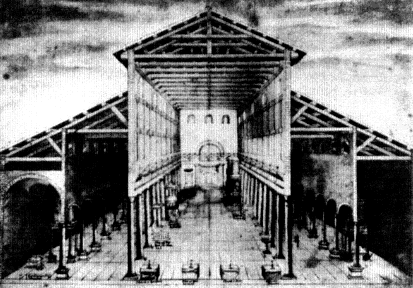
Figure 1.
Drawing of old St. Peter's made by Domenico Tasselli between 1605 and
1611; ACSP, Album, fol. 12.
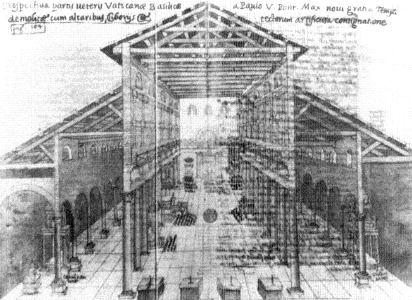
Figure 2.
Drawing of old St. Peter's made by Giacomo Grimaldi (based on Tasselli) ca.
1619-20; ACSP, Album, fols. 104v-105r.
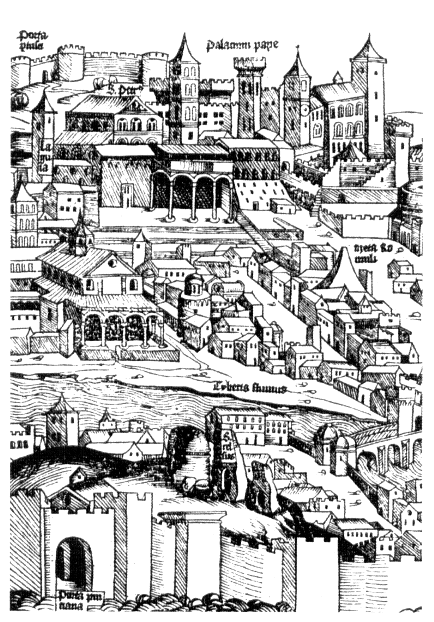
Figure 3.
View of old St. Peter's and the Vatican in the late fifteenth century; a detail
from Hartmann Schedel, Liber cronicarum (Rome, 1493).
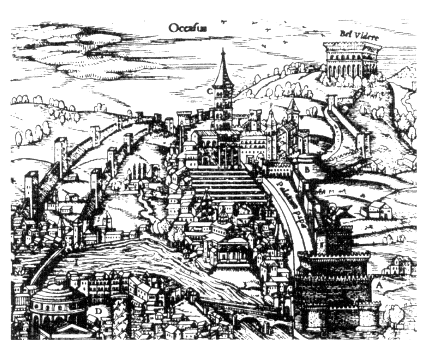
Figure 4.
View of old St. Peter's and the Vatican in the late fifteenth century; a
detail from Sebastian Münster, Cosmographiae universalis Lib. VI.
(Basel, 1550).
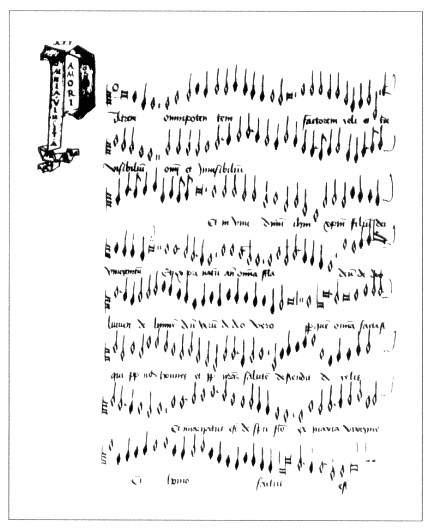
Figure 5.
SPB80, fol. 83v. Initial at beginning of Barbingant, Missa Terriblement, Patrem.
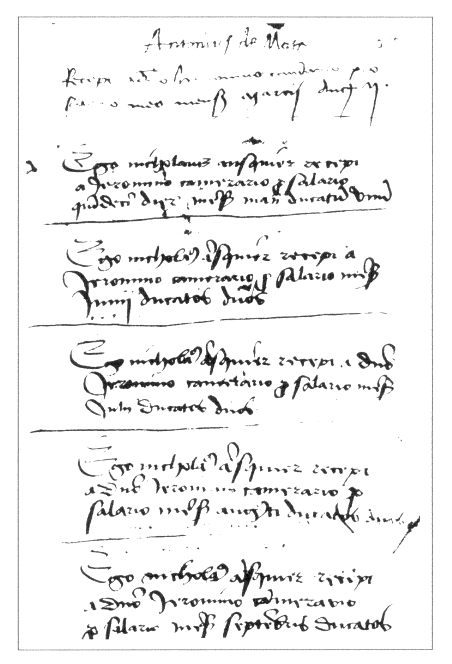
Figure 6.
ACSP, Quietanza no. 6 (1474), fol. 87r.
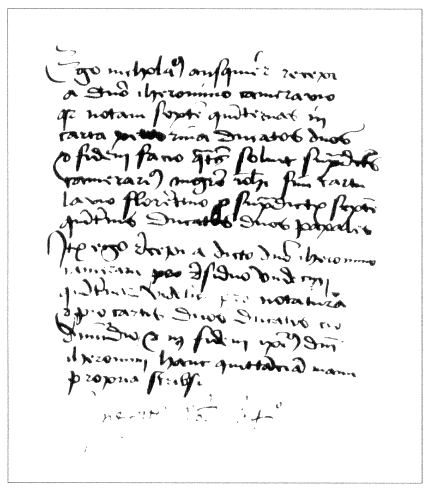
Figure 7.
ACSP, Quietanza no. 6 (1474), fol. 87v.
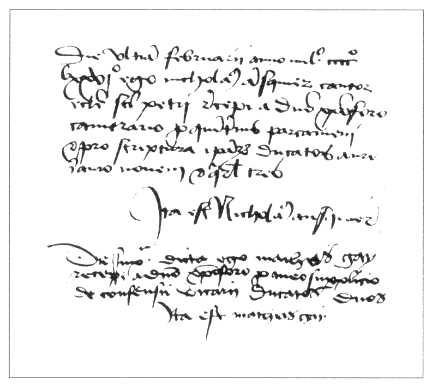
Figure 8.
ACSP, Quietanza no. 7 (1475), fol. 92r.
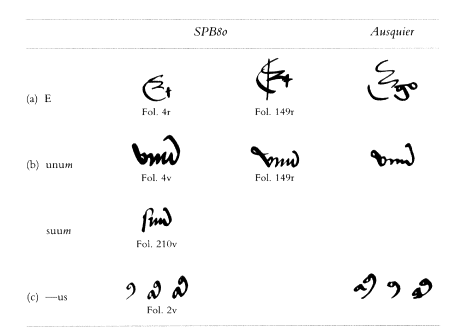
Figure 9.
Comparison of main text hand in SPB80 with receipts of Nicholas Ausquier:
a) capital E in SPB80, fols. 4r and 149r, and ACSP, Quietanza no. 6, fol. 87r; b)
"m" abbreviation in SPB80, fols. 4v and 149r, and ACSP, Quietanza no. 6, fol. 87r;
and c) "us" abbreviation in SPB80, fol. 2v, and ACSP, Quietanza no. 6, fol. 87r.
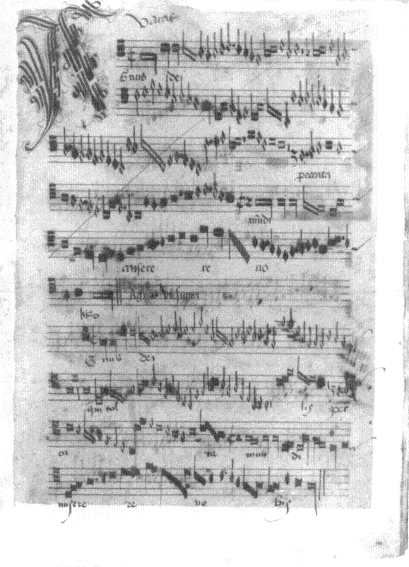
Figure 10.
The revised Agnus II for Faugues's Missa L'homme armé, CS14, fol. 149.
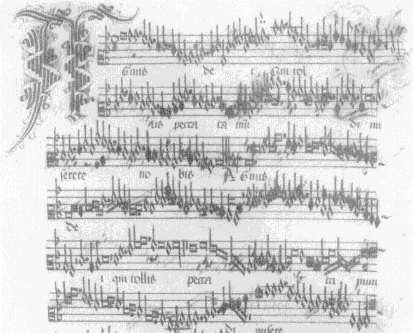
Figure 11.
Corrections by later hand in Faugues's Missa Vinnus vina, CS51, fol. 79v.
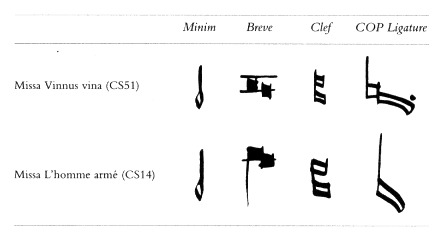
Figure 12.
Comparison of correction hand in Faugues's Missa Vinnus vina (CS51, fols. 79v,
69r, 80v, and 70r) and Missa L'homme armé (CS14, fol. 149).
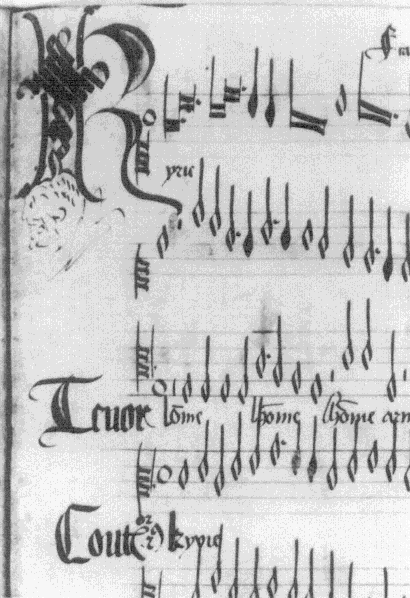
Figure 13.
Human face drawn at beginning of Caron's Missa L'homme
Sarmé, SPB80, fol. 99r.
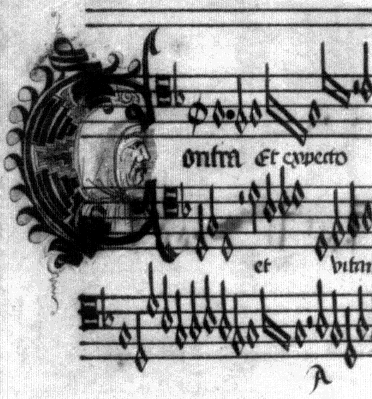
Figure 14.
Portrait of a cleric drawn in Caron's Missa L'homme
armé, CS14, fol. 133r.
| |||||||||||||||||||||||||||||||||||||||||||||||||||||||||||||||||||||||||||||||||||||||||||||||||||||||||||||||||||||||||||||||||||||||||||||||||||||||||||||||||||||||||||||||||||||||||||||||||||||||||||||||||||||||||||||||||||||||||||||||||||||||||||||||||||||||||||||||||||||||||||||||||||||||||||||||||||||||||||||||||||||||||||||||||||||||||||||||||||||||||||||||||||||||||||||||||||||||||||||||||||||
| ||||||||||||||||||||||||||||||||||||||||||||||||||||||||||||||||||||||||||||||||||||||||||||||||||||||||||||||||||||||||||||||||||||||||||||||||||||||||||||||||
| |||||||||||||||||||||||||||||||||||||||||||||||||||||||||||||||||||||||||||||||||||||||||||||||||||||||||||||||||||||||||||||||||||||||||||||||||||||||||||||||||||||||||||||||||||||||||||||||||||||||||||
(Table continued on next page)
| ||||||||||||||||||||||||||||||||||||||||||||||||||||||||||||||||||||||||||||||||||||||||||||||||||||||||||||||||||||||||||||||||||||||||||||||||||||||||||||||||||||||||||||||||||||||||||||||||||||||||||||||||||
(Table continued on next page)
| ||||||||||||||||||||||||||||||||||||||||||||||||||||||||||||||||||||||||||||||||||||||||||||||||||||||||||||||||||||||||||||||||||||||||||||||||||||||||||||||||||||||||||||||||||||||||||
| ||||||||||||
| ||||||||||||||||||||||||||||||||||||||||||||||||||||||||||||||||||||||||||||||||||||||||||||||||||||||||||||||||||||||||||||||||||||||||||||||||||||||||||||||||||||||||||||||||||||||||||||||||||||||||||||||||||||||||||||||||||||||||||||||||||||||||||||||||||||||||||||||||||||||||||||||
(Table continued on next page)
| ||||||||||||||||||||||||||||||||||||||||||||||||||||||||||||||||||||||||||||||||||||||||||||||||||||||||||||||||||||||||||||||||||||||||||||||||||||||||||||||||||||||||||||||||||||||||||||||||||||||||||||||||||||||||||||||||||||||||||||||||||||||||||||||||||||||||||||||||||||||||||||||||||||||||||||||||||||||||||||||||||||||||||||||||||||||||||||||||
| ||||||||||||||||||||||||||||||||||||||||||||||||||||
| |||||||||||||||||||||||||||||||||||||||||||||||||||||||||||||||||||||||||||||||||||||||||||||||||||||||||||||||||||||||||||||||||||||||||||||||||||||||||||
| |||||||||||||||||||||||||||||||||||||||||||||||||||||||||||||||||||||||||||||||||||||||||||||||||||||||||||||||||||||||||||||||||||||||||||||||||||||||||||
| ||||||||||||||||||||||||||||||||||||||||||||||||||||||||||||||||||||||||||||||||||||||||||||||||||||||||||||
| |||||||||||||||||||||||||||||||||||||||||||||
| ||||||||||||||||||||||||||||||||||||||||||||||||||||||||||||||||||||||||||||||||
| ||||||||||||||||||||||||||||||||||||||||||||||||||||||||||||||||||||||||
| ||||||||||||||||||||||||
| ||||||||||||||||||||||||
| ||||||||||||||||||||||||||||||||||||||||||||||||||||||||||||||||||||||||||||||||||||||||||||||||||||||||||||||||||||||||||||||||||||||||||||||||||||||||||||||||||||||||
(Table continued on next page)
| ||||||||||||||||||||||||||||||||||||
| ||||||||||||||||||||||||||||||||||||||||||||||||||||
(Table continued on next page)
| |||||||||||||||||||||
| ||||||||||||||||||||||||||||||||||||||||||||||||||||||||||||||||||||||||||||||||||||||||||||||||||||||||||||||||||||||||||||||||||||||||||||||||||||||||||||||||||||||||
(Table continued on next page)
| ||||||||||||||||||||||||||||||||||||
| |||||||||||||||||||||||||||||||||
(Table continued on next page)
| ||||||||||||||||||||||||
| |||||||||||||||||||||||||||||||||||||||||||||||||||||||||||||||||||||
|
| ||||||||||||||||||||||||||||||||||||||||||||||||||||||||||||||||||||||||||||||||||||
(Table continued on next page)
| ||||||||||||||||
|
| ||||||||||||||||||||||||||||||||||||||||||||||||||||||||||||||||||||||||||||||||||||||||||||||||||||||||||||||||||||||||||||||||||||||||||||||||||||||||||||||||||||||||||||||||||||||||||||||||
| ||||||||||||||||||||||||||||||||||||||||||||||||||||||||
| |||||||||||||||||||||||||||||||||||||||||||||||||||||||||||||||||||||||||||
(Table continued on next page)
| ||||||||||||||||||||||||||||||
| |||||||||||||||||||||||||||||||||||||||||||||||||||||||||||||||||||||||||||||||||||||||||||||||
| |||||||||||||||||||||||||||||||||||||||||||||||||||||||||||||||||||||||||||||||||||||||||||||||||||||||||||||||||||||||||||||||||||||||||||||||||||||||||||||||||||||||||||||||||||||||||||||||||||||||||||||||||||||||||||||||||||||||||||||||||||
(Table continued on next page)
| |||||||||||||||||||||||||||||||||||||||||||||||||||||||||||||||||||||||||||||||||
| ||||||||||||||||||||||||||||
|
| ||||||||||||||||||||||||||||||||||||||||||||
|










































































































